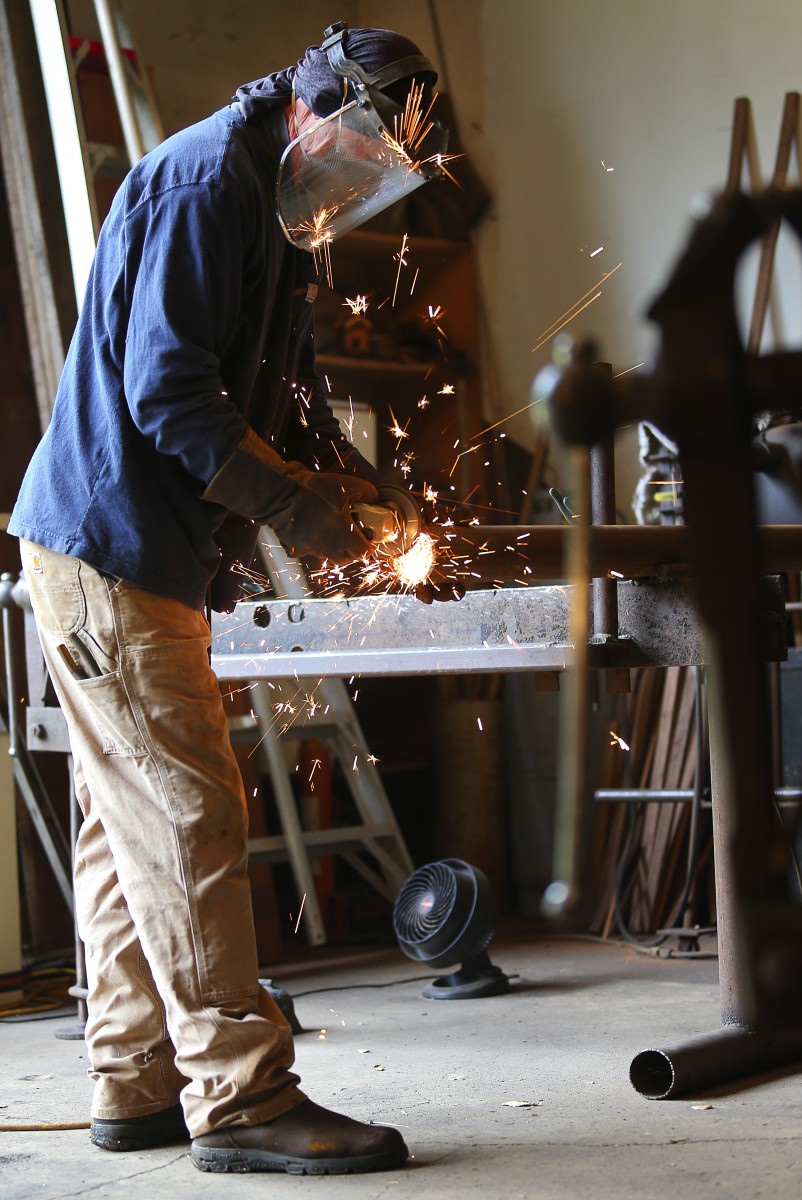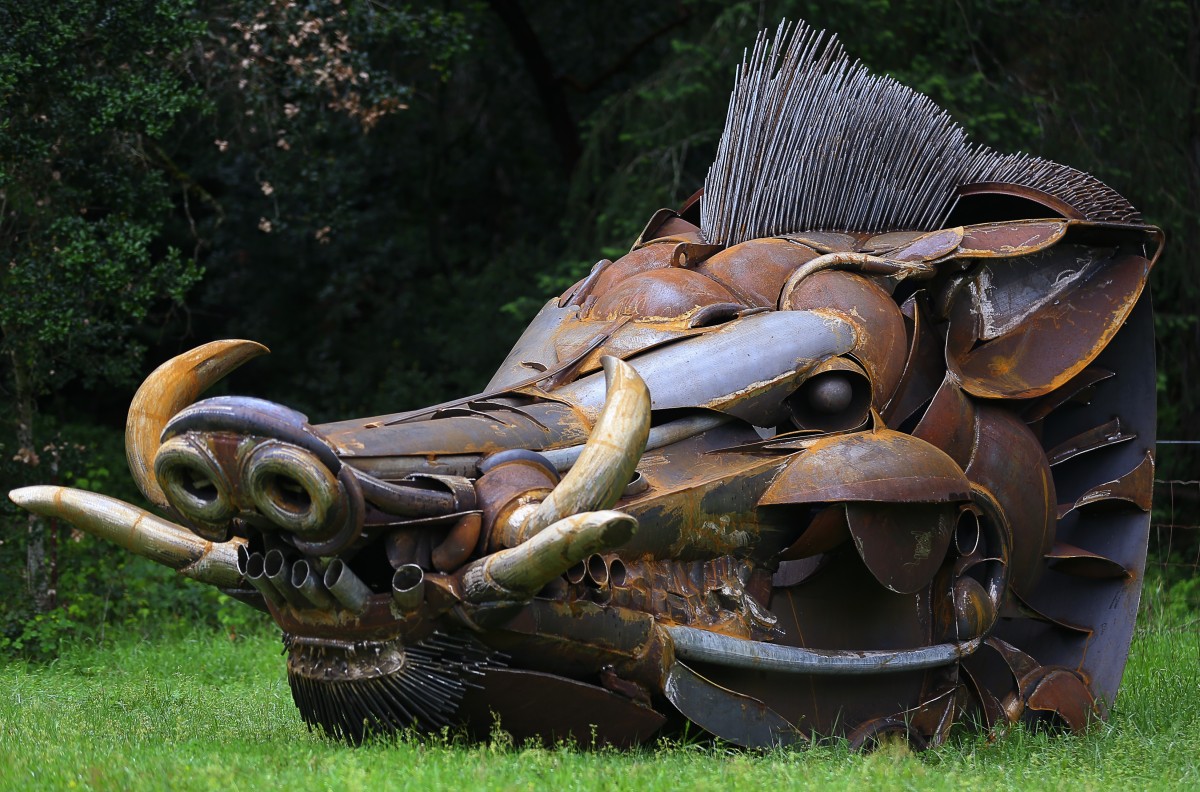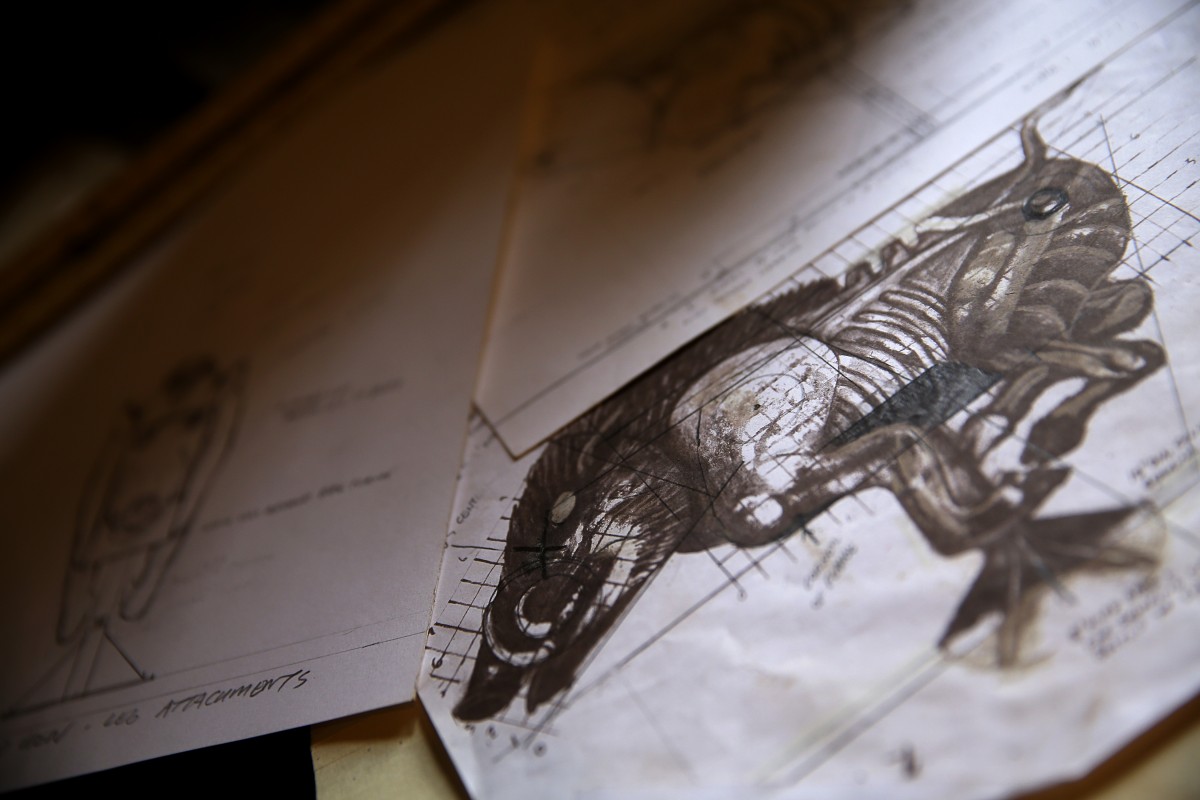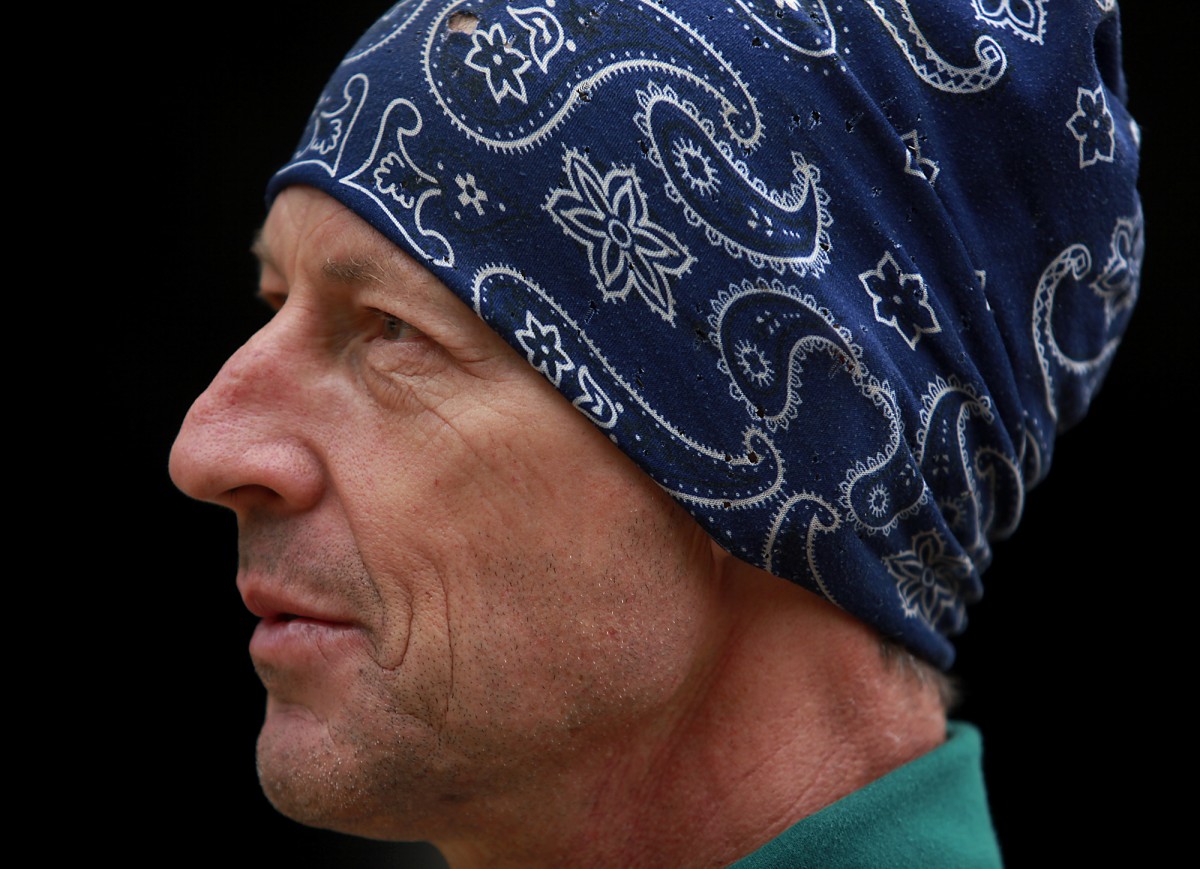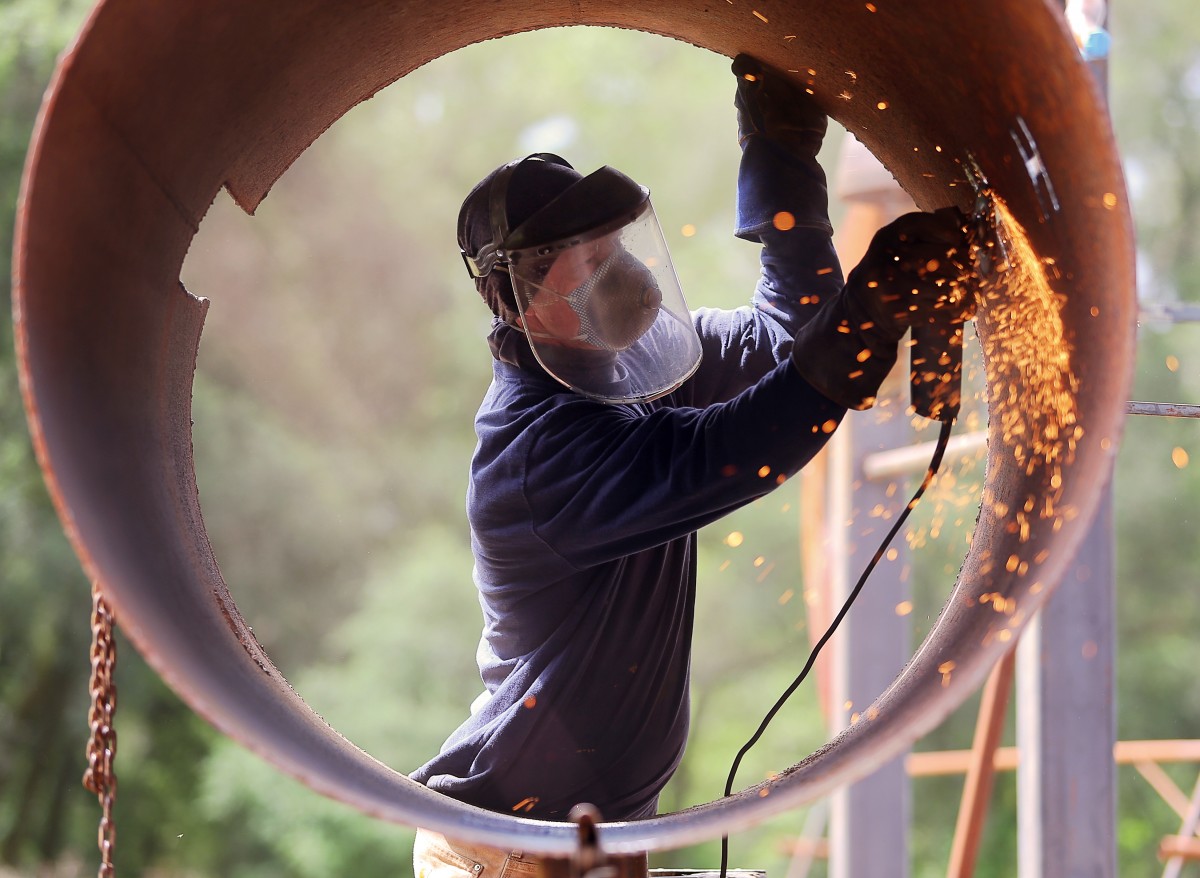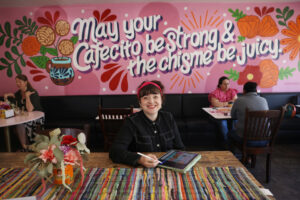
When it comes to public art, Sonoma County-based artist and graphic designer Blanca Molina goes big.
The post Maximalist Muralist Blanca Molina Spreads Color and Joy Throughout Sonoma County appeared first on Sonoma Magazine.
]]>
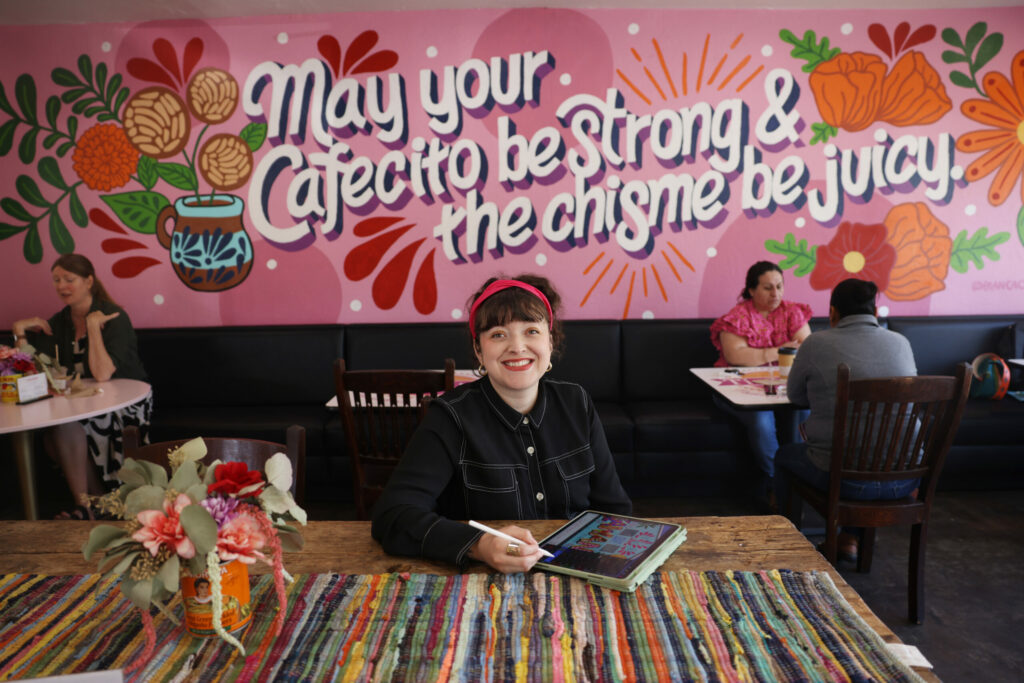
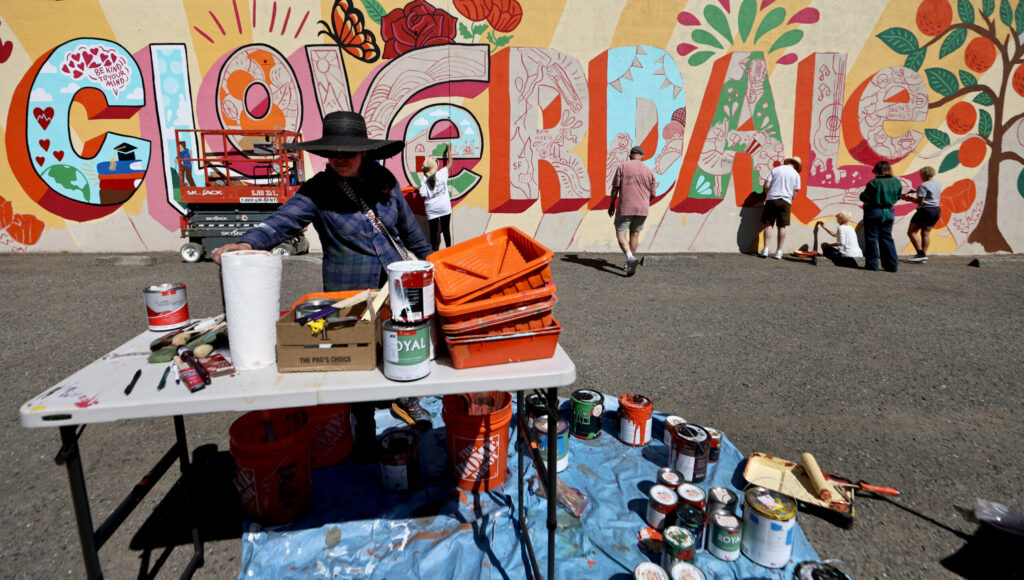
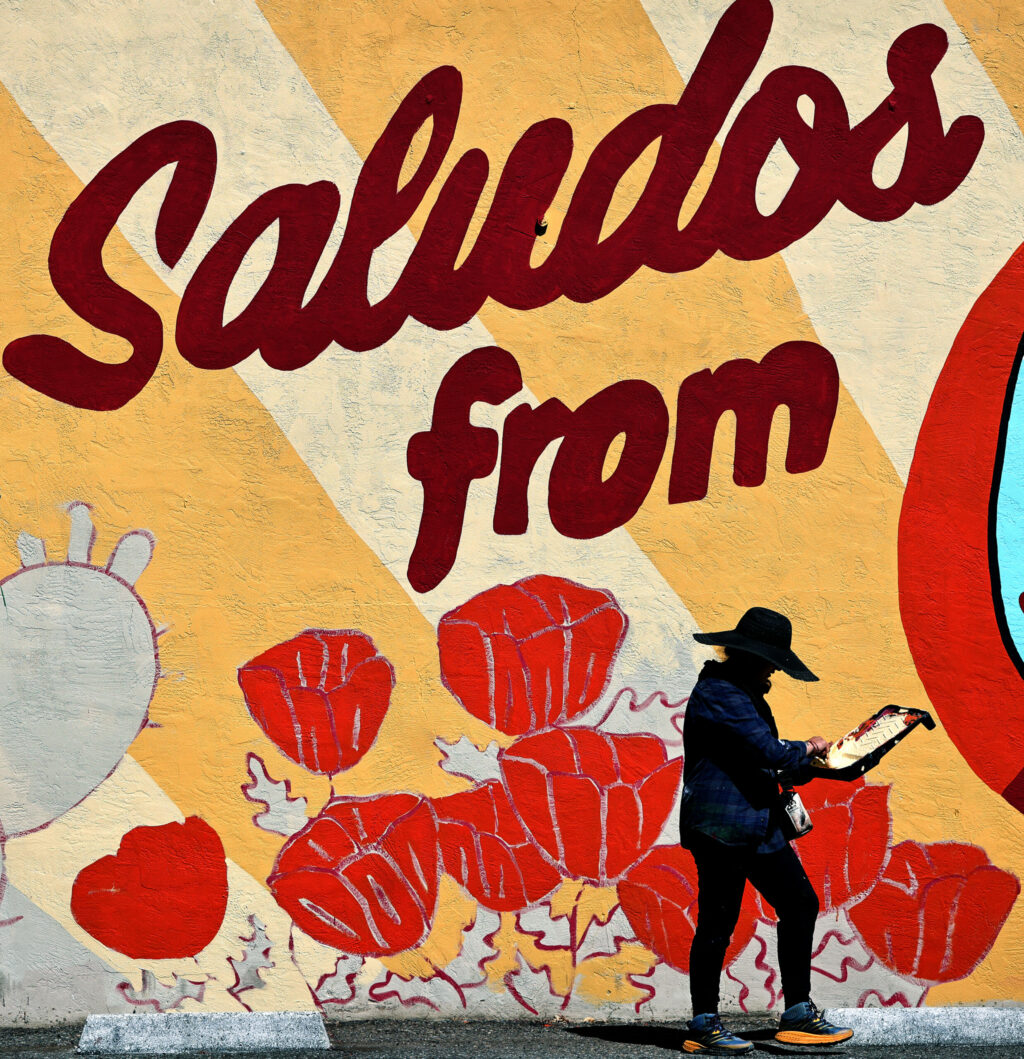

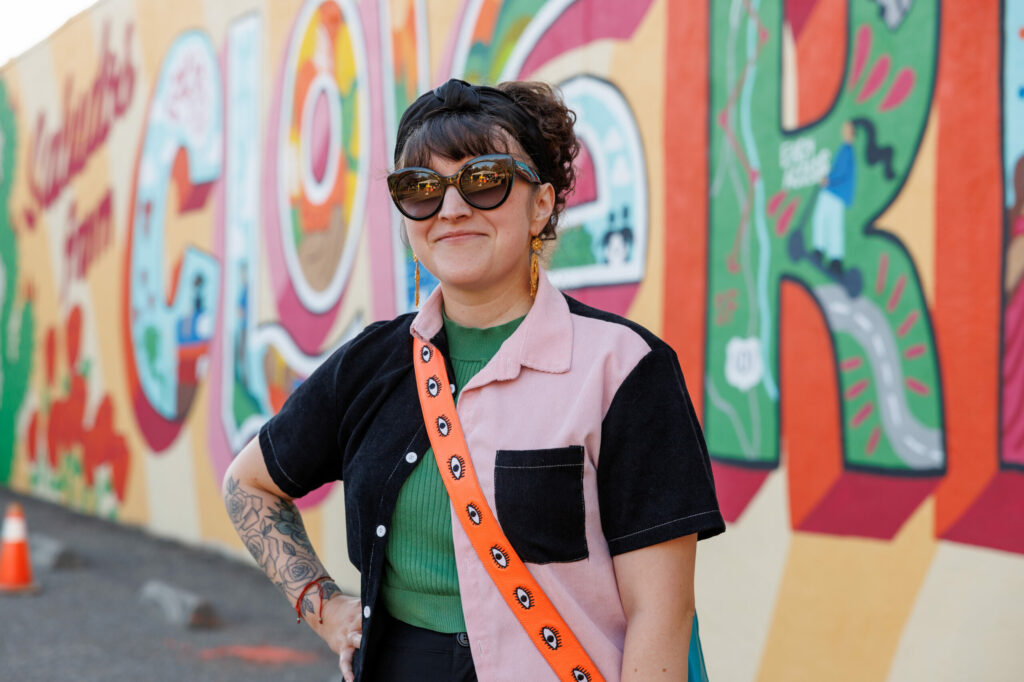
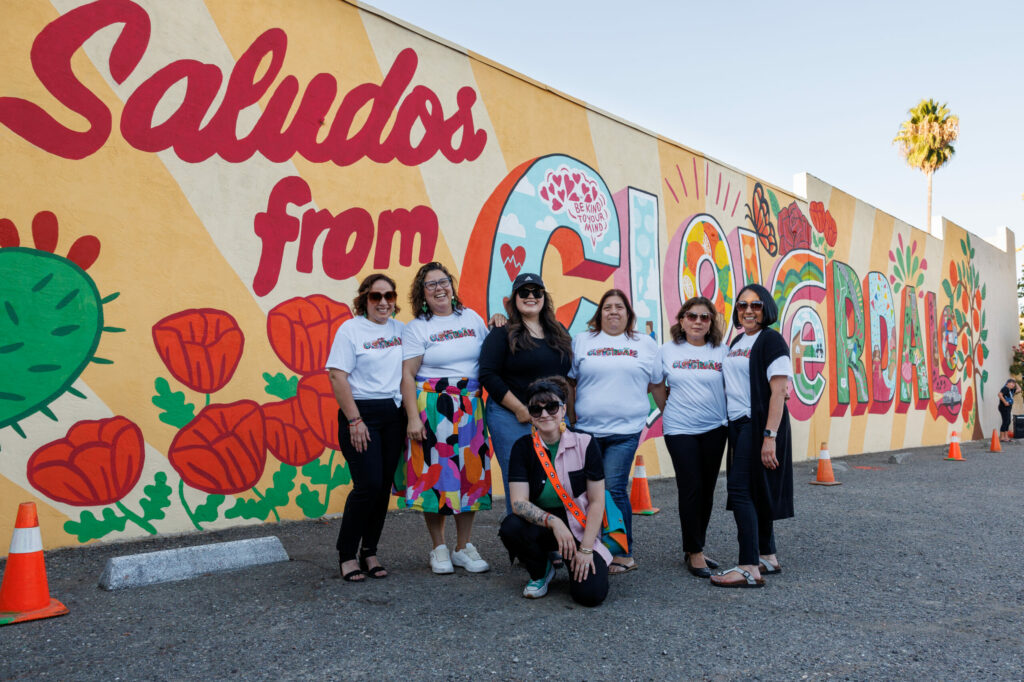

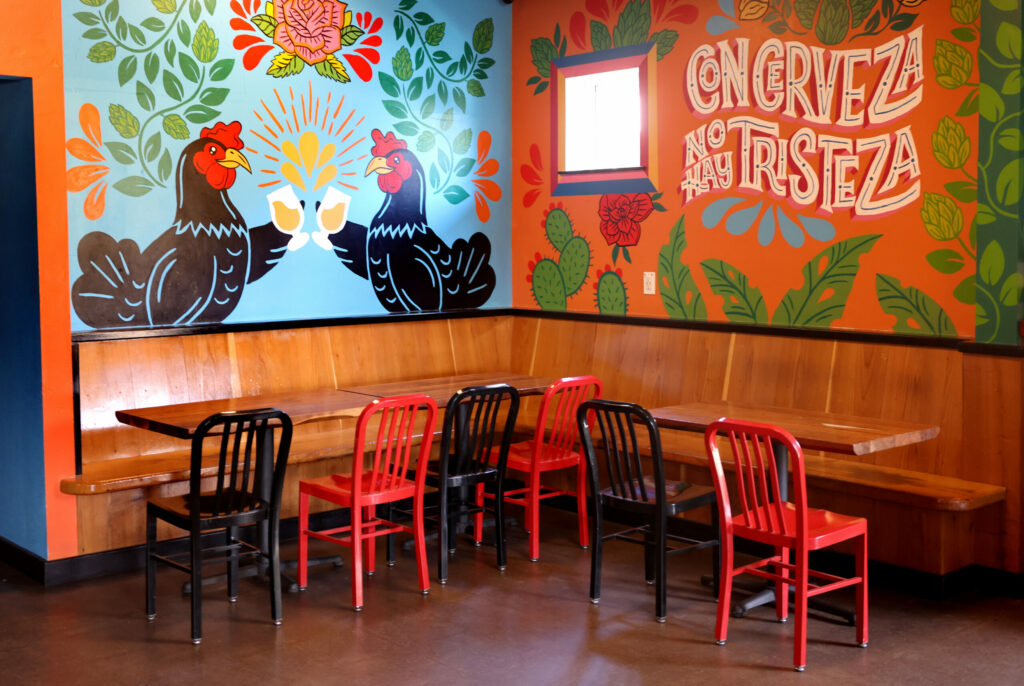
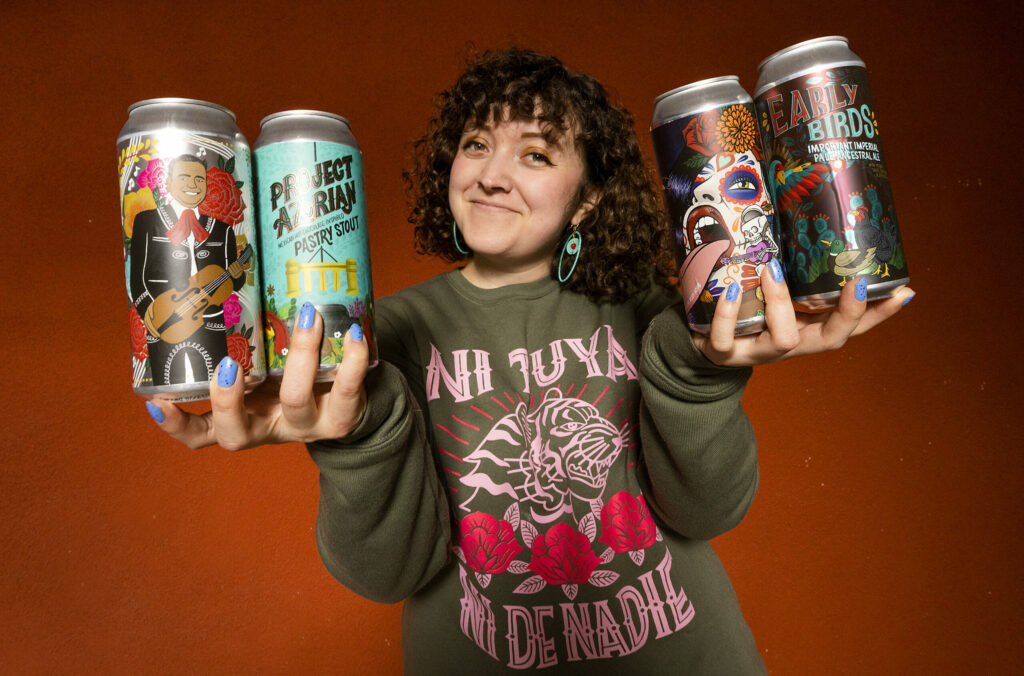
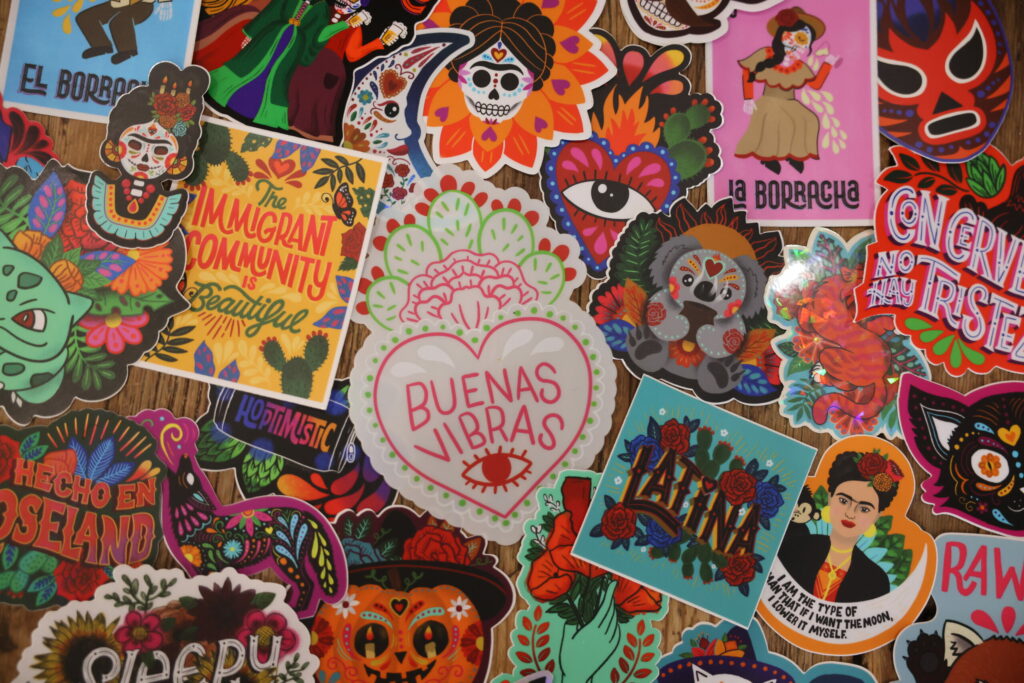
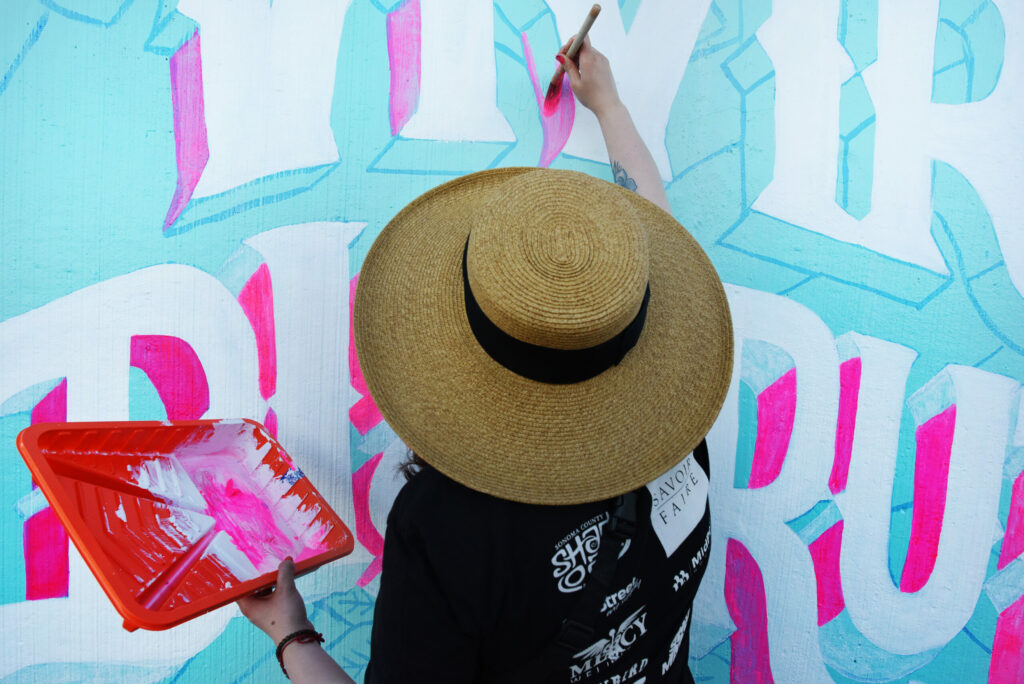
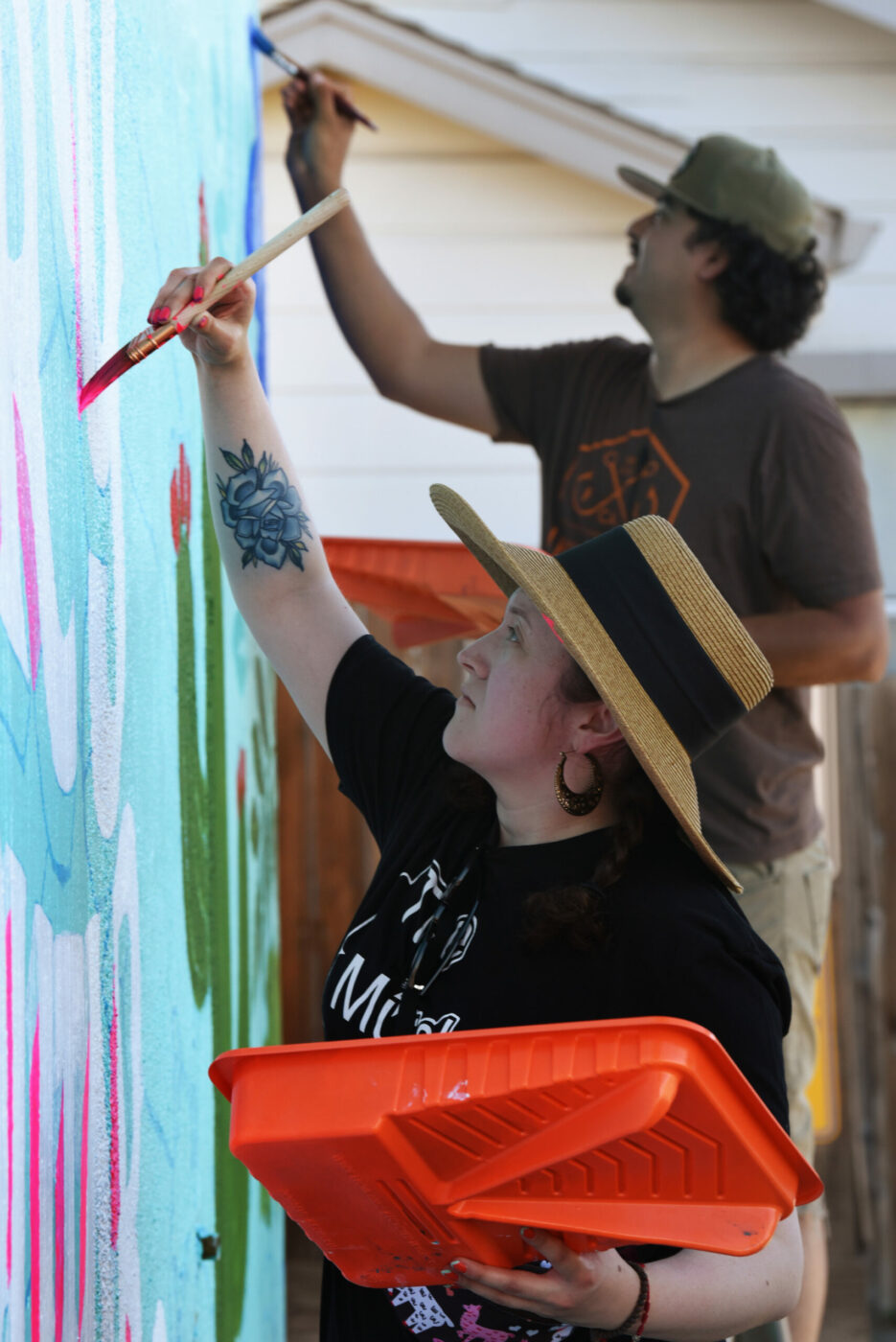
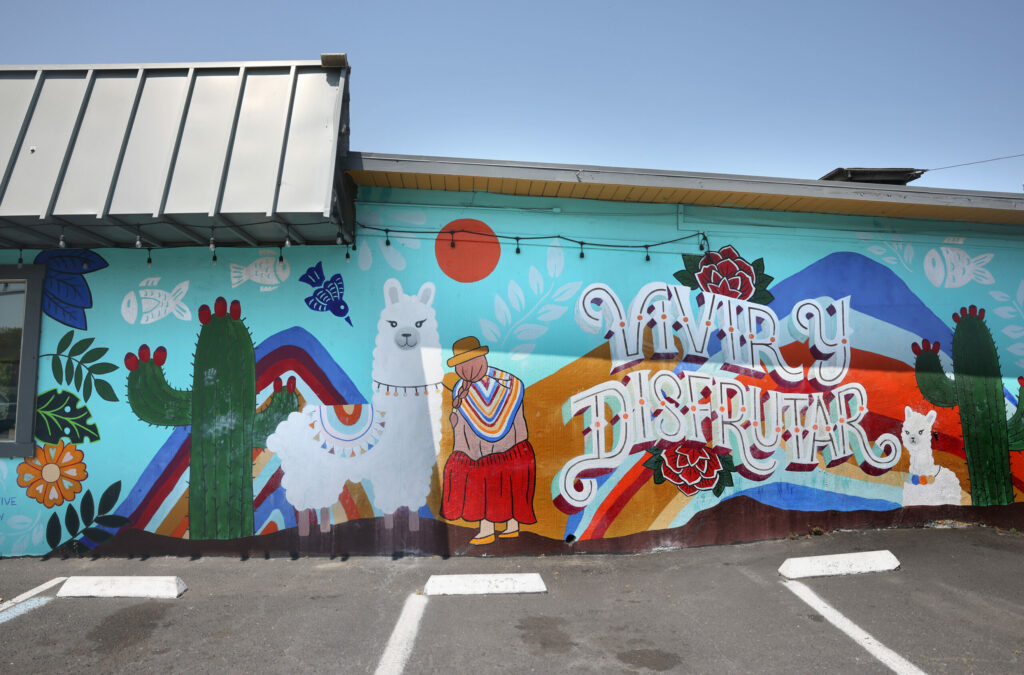
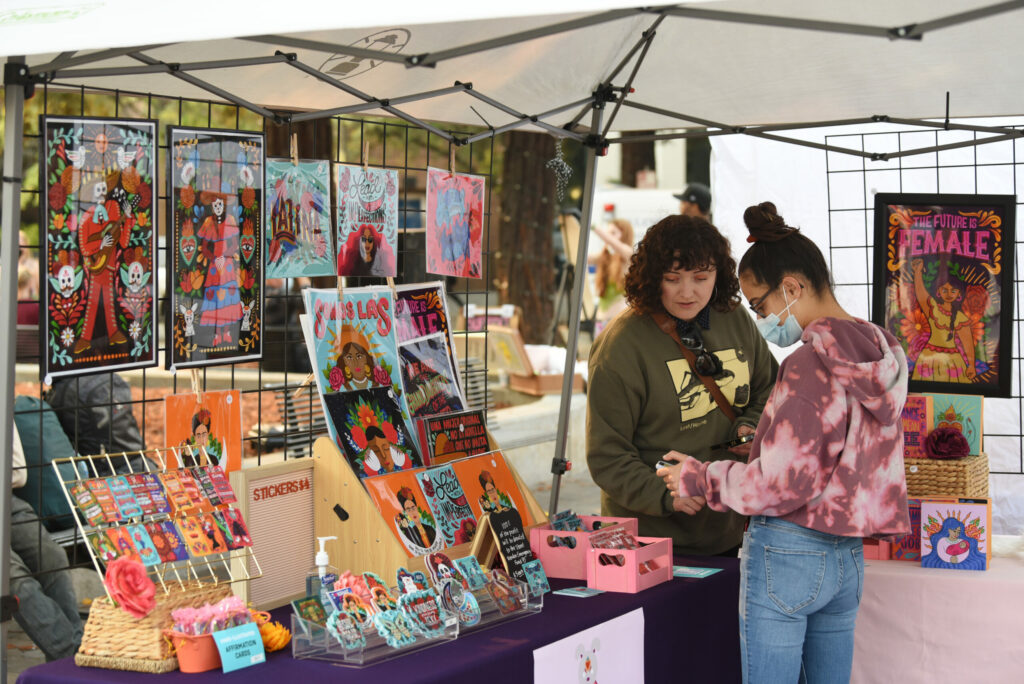
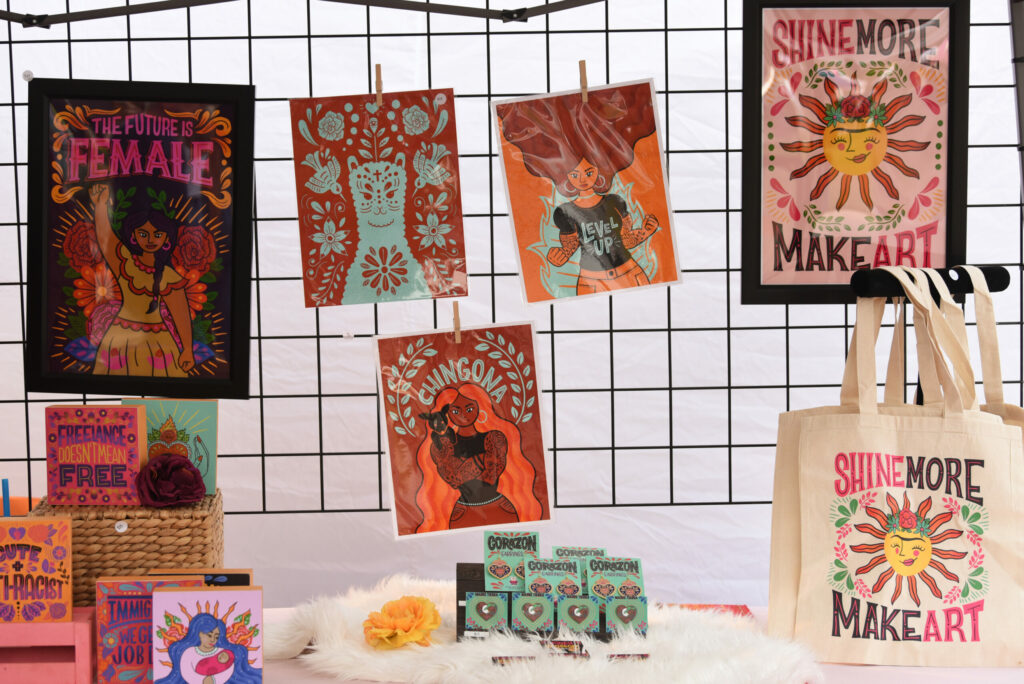
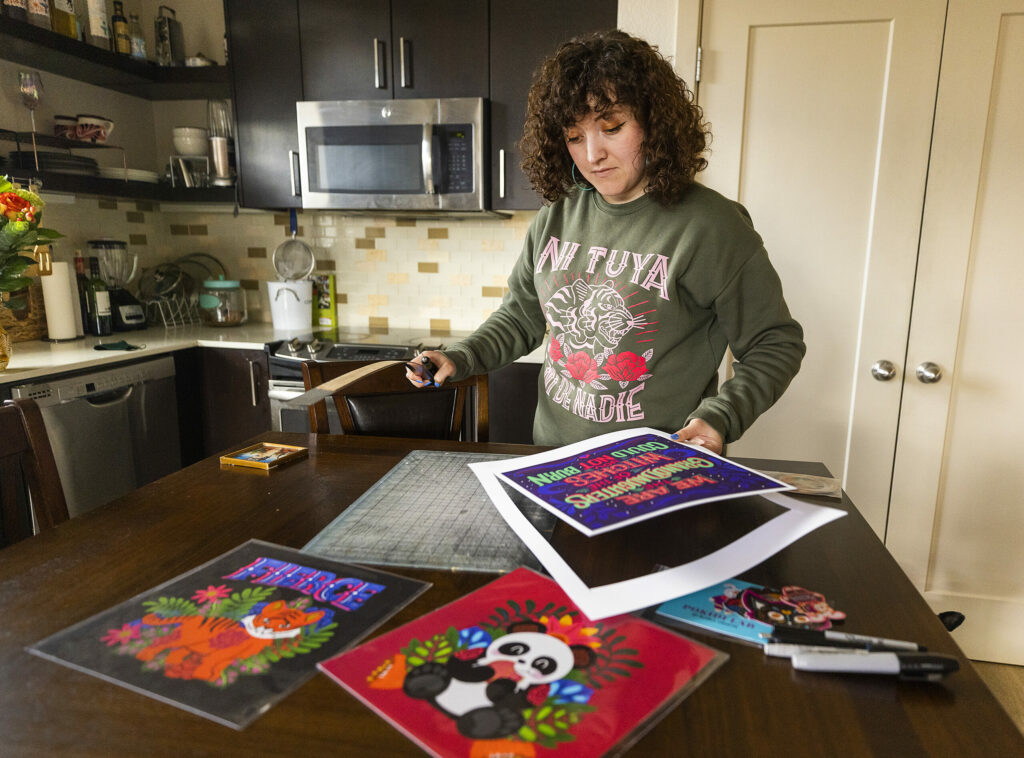
Blanca Molina sits in Tía María bakery in Santa Rosa’s Roseland neighborhood, studying her latest project on her iPad. At a table behind her, two women chat over cups of coffee, their conversation framed by a bright pink backdrop adorned with pops of orange florals and a bouquet of conchas sprouting from a café de olla that reads, “May your cafecitos be strong and your chisme be juicy.”
“Chisme means gossip,” explains Molina of the mural she created for the bakery this spring — one that might make you ponder: Does life imitate art, or does art imitate life?
For Molina, that philosophical question matters less than creating something that brings a smile to someone’s face. “Spreading joy and happiness with my art has always been my number one goal,” she says.
And she succeeds. Her creations are vibrant, bold, and lush. Describing herself as a “Latina maximalist,” Molina embraces a “more is more” approach. “I always want to add more pops of color, more movement. Make it busy, but clean. Organized chaos, I guess,” she explains.
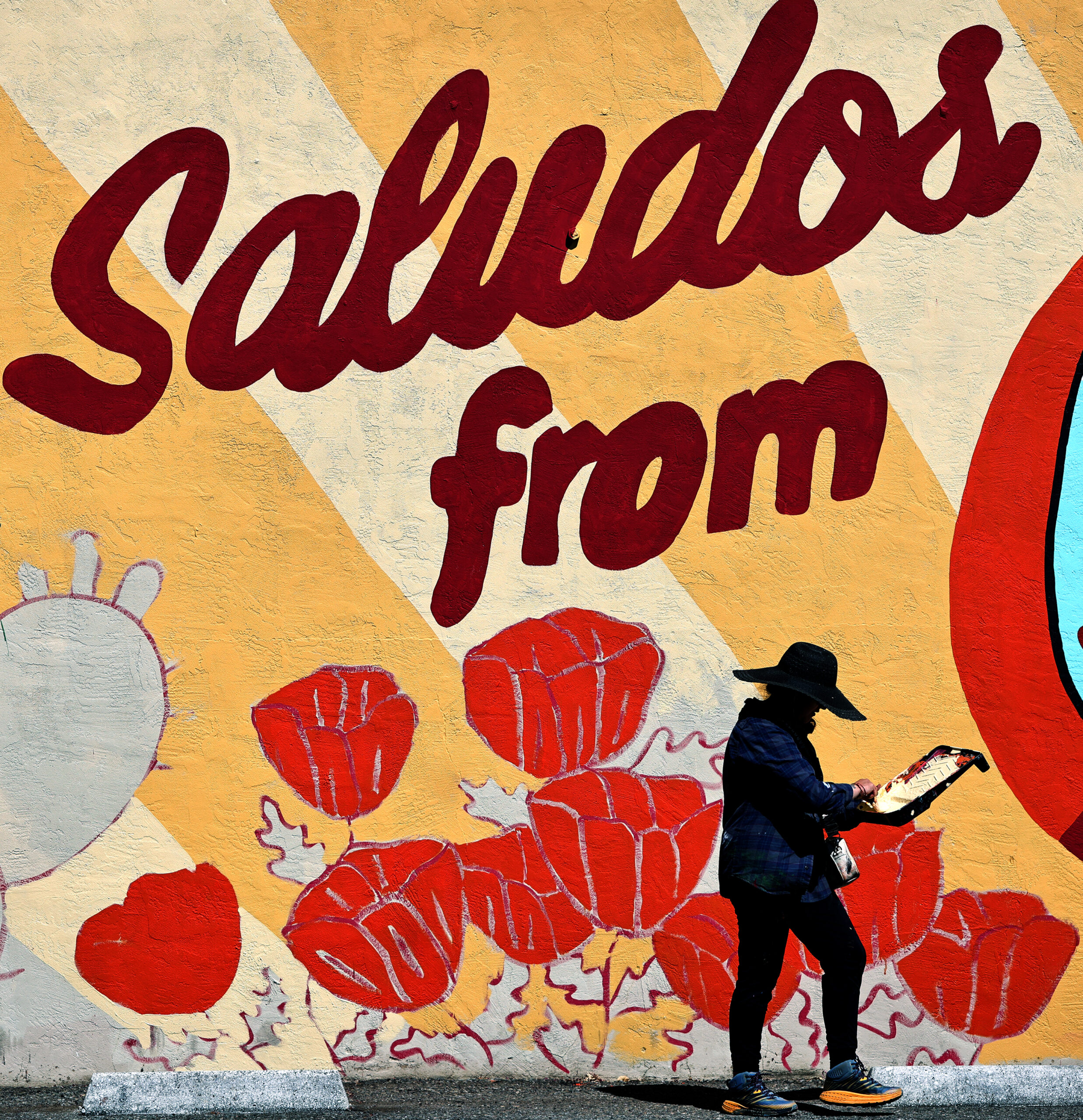
At its core, Molina’s art represents a yearning to capture the life her family left behind when they immigrated to California from Jalisco, Mexico, when she was 5 years old. “I kind of missed out on my culture by not being over there, so the only way I could connect to it is by drawing things that are important to the Mexican culture,” she says.
Molina is especially drawn to pink and orange hues, colors significant to Día de los Muertos, which also happens to be her busiest time of year. She recently completed a Día de los Muertos project for Lush Cosmetics, creating packaging that will be released this autumn.
The imagery of sugar skulls and brujas (witches) — inspired by the holiday — features prominently in her artwork and has brought her considerable attention. But her work also incorporates American influences. “I grew up here, so I do use a lot of Spanglish,” she says of her designs.
After her family settled in Napa, Molina, her parents, and her two siblings moved to a property in Alexander Valley where her father managed a vineyard. She worked at the nearby Jimtown Store during college and credits the store’s owner at the time, Carrie Brown, with influencing her artistic approach. “She’s very colorful in her way of putting foods together. It influenced my art down the line,” Molina recalls.
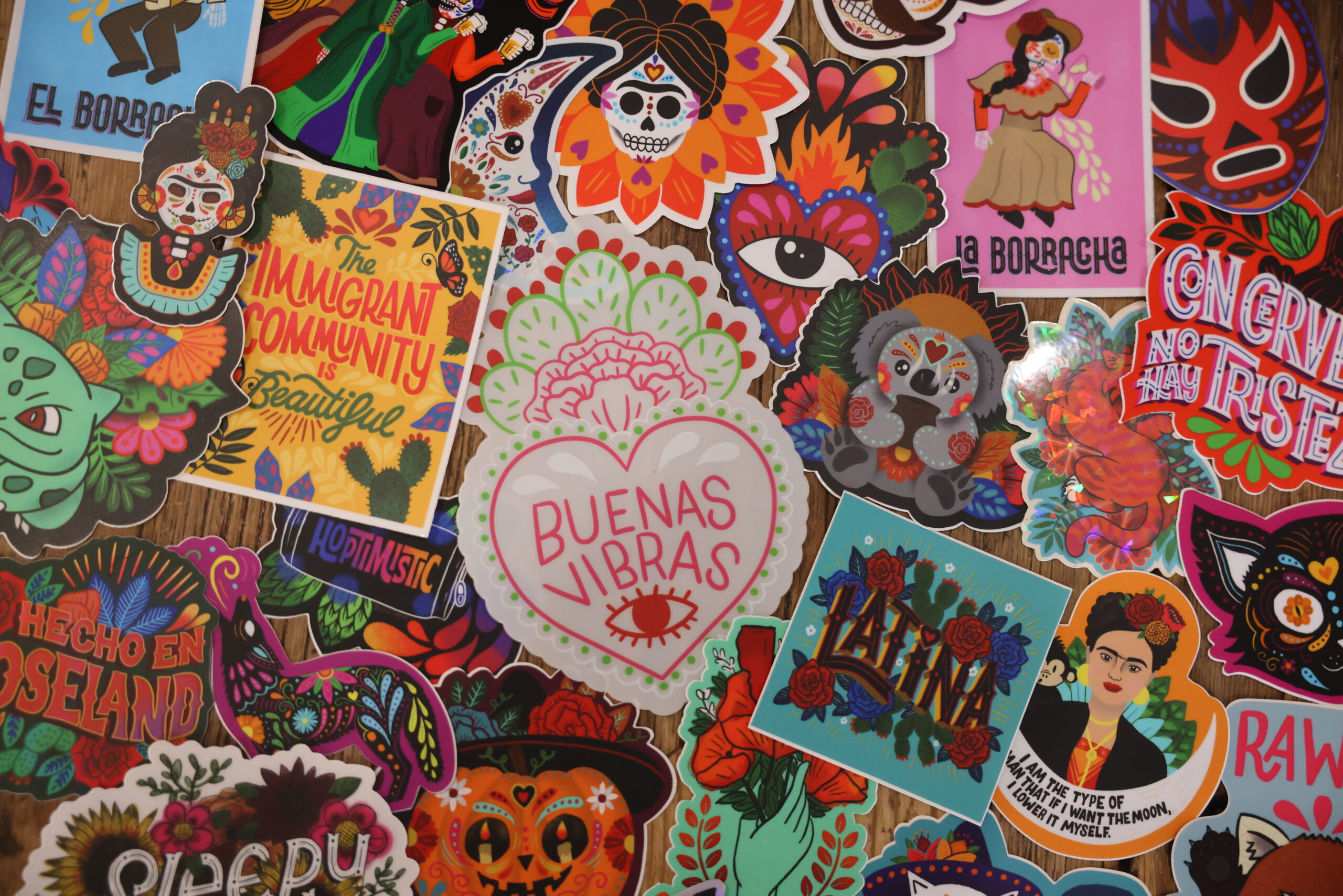
A career graphic designer, Molina learned early on, while a student at Healdsburg High School, that creativity can be a powerful tool for tackling tough topics. “Sometimes, the topics weren’t even that interesting to me, but I knew I had to do a poster and the poster made me more excited about it.” Some teachers even complimented her ability to make “boring” subjects more engaging.
Even now, with her use of vivid colors and joyful artwork, she manages to broach subjects like immigration, feminism, and self-actualization with a sense of humor — albeit with a subversive spin, but only in the nicest way possible. “I don’t like to say negative things, I like to spread positivity,” she says of her images with messages like “The immigration community is beautiful” and “The future is female.”
Molina’s message of joy and positivity flourishes for all to see in her artwork. Her murals, largely concentrated in the Roseland neighborhood, are public-facing art. In addition to the one at Tía María, another at nearby HenHouse Brewing reads, “con cerveza, no hay tristeza.” Molina says, “It sounds better in Spanish,” but translates it roughly to “with beer, there is no sadness.”


Her first design, “vivir y disfrutar,” painted in 2022 on the side of Sazón Peruvian restaurant, means simply to “live and enjoy life” — a reminder, perhaps, to the sometimes harried drivers on busy Sebastopol Road to slow down and take it easy.
Her newest mural design, debuting this summer, is mobile — a bus in Napa Valley will be fully wrapped in her artwork, incorporating, among other things, vineyards, a vineyard worker, and a woman holding a glass of wine on one side. On the other, orange poppies and the California bear appear — in this iteration, with a pair of monarch butterfly wings. (The bear on the California flag was inspired by a bear named “Monarch,” one of the last California grizzlies in captivity.)
Although all her murals are impressive, none are so precious as to be tucked away in an intimidating gallery or hushed museum. The medium is the message: This is art for everybody.
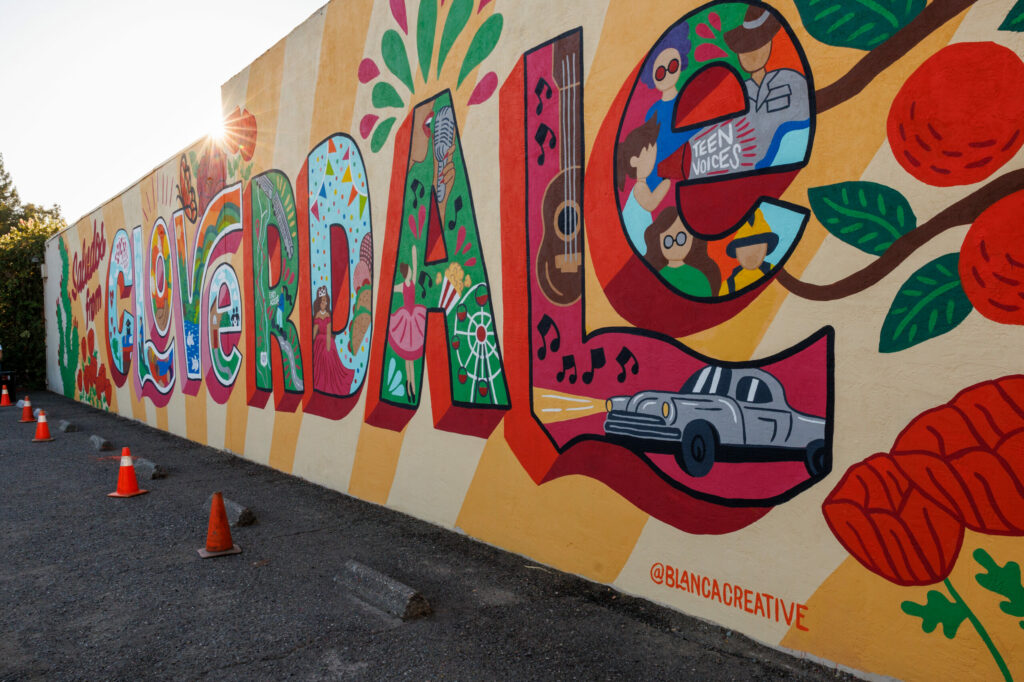
The mural in Molina’s new hometown, Cloverdale, which was unveiled last year, was a turning point for how she approaches projects. Through a series of meetings organized with Kimzin Creative, community members gave input about meaningful images to include. The themes they selected were incorporated into letters that spell out “Cloverdale” for a 60-foot mural on the side of the Encore Dance Theater on Cloverdale Boulevard.
To create a mural, Molina photographs the wall, then uses its exact dimensions for her design. In her home office, she creates a digital image on a computer with a giant screen that allows her to easily see her more detailed work.
When it’s time to turn virtual into reality, she uses a laptop to project the outline of her design onto the wall, then traces it, quickly, sometimes in chalk, sometimes with paint. For large projects, like the Cloverdale mural, she projects a quadrant at a time, carefully piecing it together.


When it came time to paint the Cloverdale mural, the community got to help — a first for Molina. She describes her work as a “very color-by-numbers kind of style,” which helps on projects where people bring varying degrees of artistic experience or, perhaps, none at all. But just because it’s easy to paint, it doesn’t mean it’s easy to design.
Creating the template, she says, is where the real work lies. “Coming up with something that other people can do, that’s where it gets tricky.” But for her, the work is worth it because that collaboration allows people to experience a deeper connection to the art. “People would go to the flower they painted, and they’ll show their family, ‘Oh, I painted that flower.’”
Now, when a business or organization asks her to create a mural, she encourages them to consider involving others. “If you bring customers in (to help), they’ll become even more loyal customers,” she says. “It’s just a beautiful feeling. It brings more positivity to that business.”
Living so close to the Cloverdale mural, Molina finds a lot of satisfaction seeing people — including city council members — take photos in front of it. “It’s like a warm hug.”
Follow on Instagram @blancacreative. blancacreative.com
Find Molina’s murals, along with murals from other local artists, scattered all around Sonoma County.
The post Maximalist Muralist Blanca Molina Spreads Color and Joy Throughout Sonoma County appeared first on Sonoma Magazine.
]]>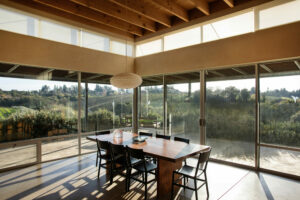
A legendary wine merchant and restaurateur forges connection to the land in rural Sebastopol. Take a look at the peaceful property.
The post Stephen Singer Discovers a System of Balance at His Sebastopol Farm appeared first on Sonoma Magazine.
]]>
















There’s a tiny sparrow fluttering and dipping its wings in a small pool of water collected at the edge of the roof that cantilevers over Stephen Singer’s porch in rural Sebastopol. It’s a moment that would have thrilled his young granddaughter, who has just left after an extended visit to the farm, and Singer looks delighted, too.
The wraparound porch overlooks a sweep of olive groves and vineyards in a small, west-facing valley punctuated with blocks of grapes and olive trees. The landscape is full of life: owls hunt for gophers and nest in boxes placed at the side of the vineyards, and ducks and occasionally river otters cavort in the seasonal stream at the bottom of the hill. “I could sit all day and watch the turkey vultures fly around,” says Singer. “They’re beautiful aviators.”
There are few as well equipped as Singer to hear the songs of all this rural bounty and beauty. A restaurateur and wine merchant, he is known for his connection to Chez Panisse, the Berkeley restaurant founded by his former wife, Alice Waters. Singer oversaw Chez Panisse’s wine program for decades, ran a landmark wine shop in San Francisco, and consulted on wine lists for dozens of restaurants while importing rare olive oils from Tuscany. (Paul Bertolli, a colleague at Chez Panisse in the early 1980s, first opened his eyes to the vibrant, fruity qualities of Tuscan olive oils.)
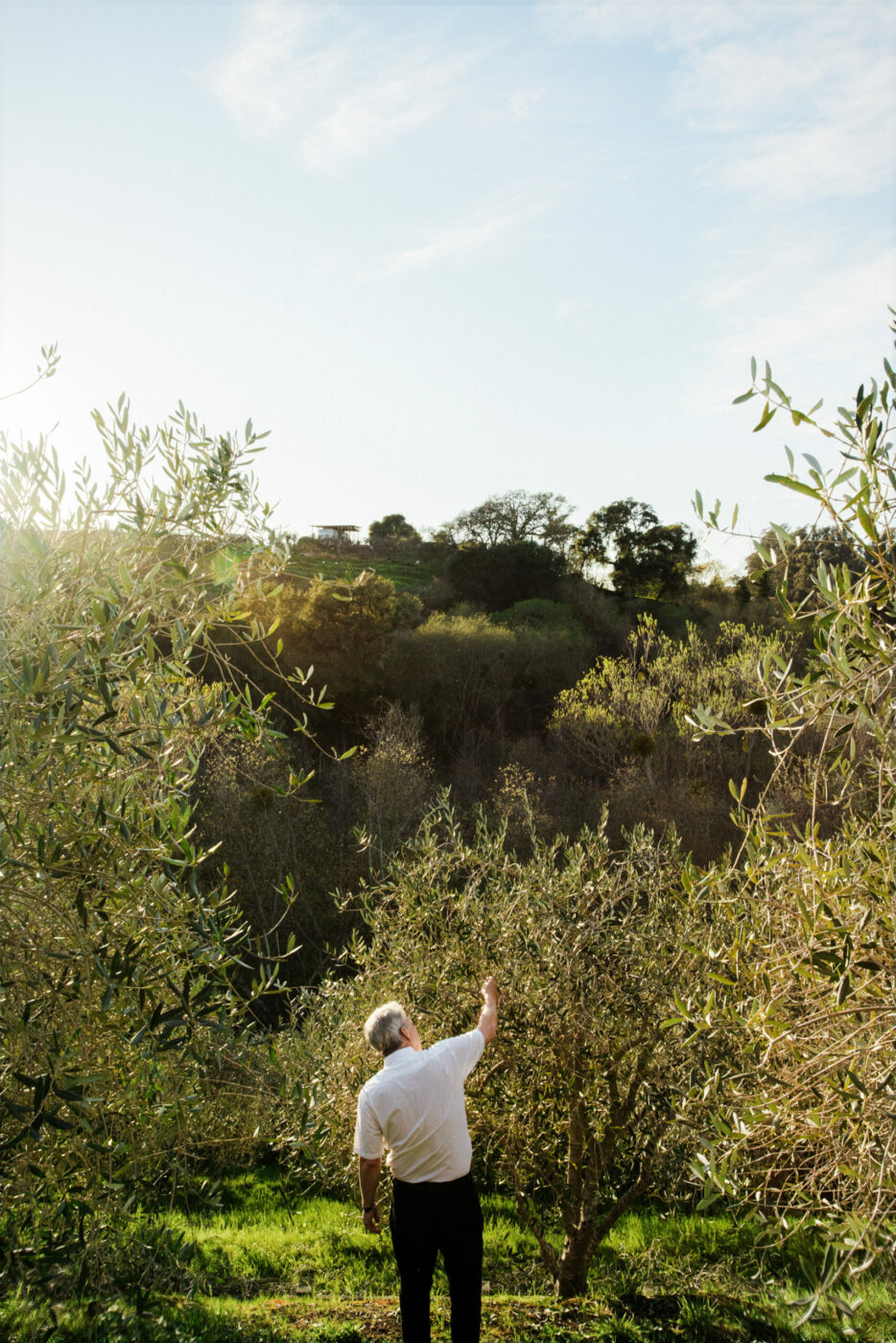
Singer now focuses his formidable energy on products from his Sebastopol farm, including wines from 6 planted acres as well as two blends of estate olive oil — staples of a gracious spread. “Wine on the table pulses with a sense of purpose,” Singer says. “It makes the table a more beautiful place, and it invites conversation and community.”
Singer is also an accomplished visual artist. His studio takes up the second floor of a corrugated metal outbuilding that houses tractors and field equipment on the ground floor and an acetaia, or vinegar-making operation, above. Singer paints with watercolors, layering dozens of thin washes of color atop the page to explore formal issues of light, space and form. He explains that while he doesn’t paint from nature per se, his work is saturated with reflections of light and color in the landscape.
The labels he created for his estate Syrah and Viognier engage with this interplay: the Syrah has a subtle design in keeping with its dark, complex character, but the Viognier reads exuberant and bright. One imagines the colors on that label in dialog with the character of both the fruit it’s made with and the light, summery foods it might accompany — it’s a “vivid, polychromatic expression,” the artist explains.

Singer first explored Sonoma County in the 1970s, riding motorcycles and cycling through the hills of west county with friends. When he was ready to make the leap, he became enamored of the idea of raw land, a place where he could realize his own built environment. Singer’s parents had built the house he grew up in, in Oklahoma, and he longed for a spot where he could assert his creativity as they had.
When he purchased the property 23 years ago, it was planted with a few thousand apple trees alongside a couple of simple farm buildings and a doublewide trailer for farmworker housing. With strong ideas for the new home he wanted to build, Singer worked collaboratively with architect Keith Anding to realize the design. The brief was for a modern, light-filled environment that gave the impression of an urban loft, with a similar flow between spaces, but on open land.
“What I really like about hypermodern architecture and design is that it draws you to the experience of the form itself,” Singer says. “As much as the house has a lot of modern elements, it hardly feels severe.”
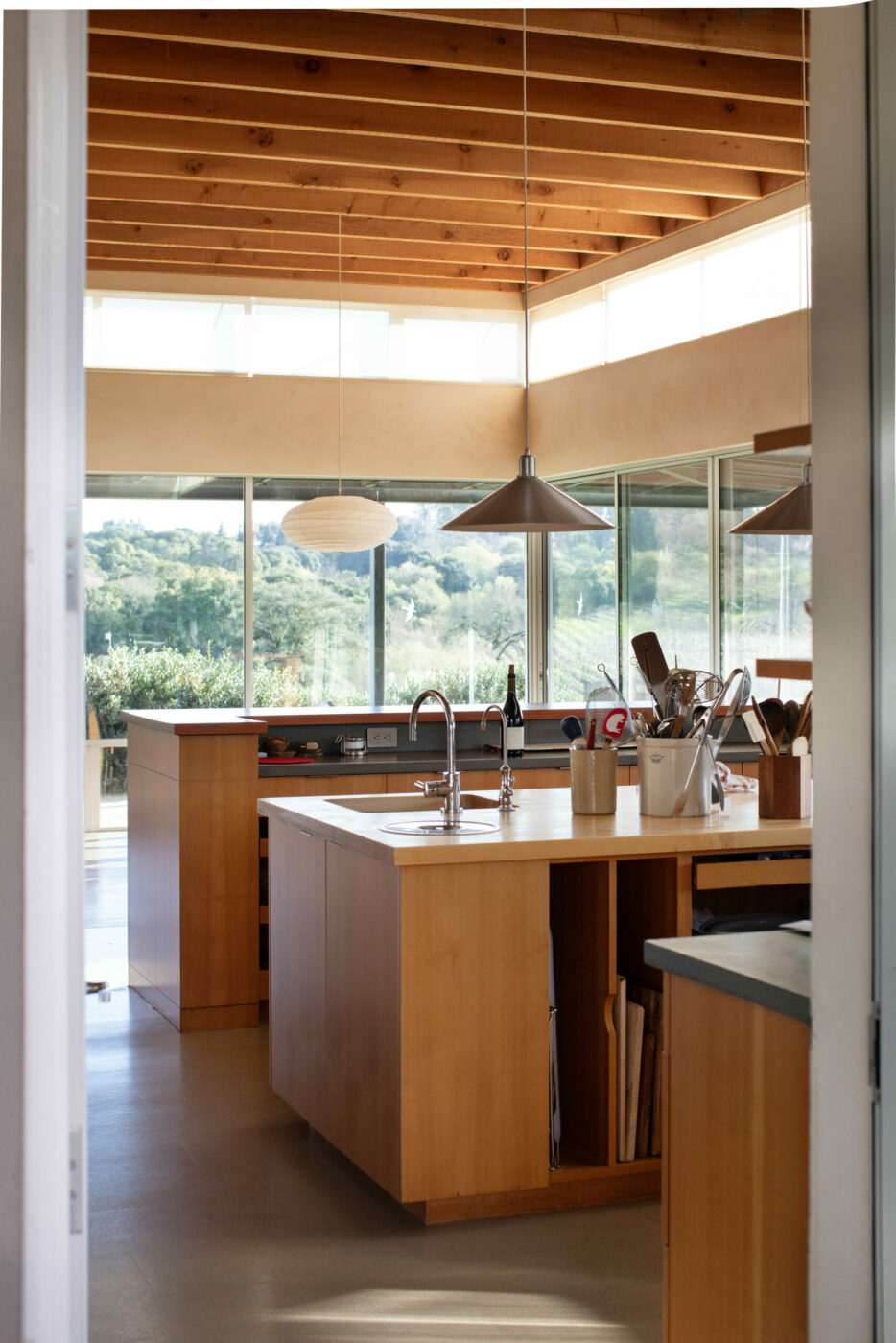
A large space for cooking and conversation centers the design. “In many ways, my house is a large kitchen with some bedrooms around it,” he reflects. The kitchen accommodates large gatherings with multiple chefs around a center island and peninsula that connect to an indoor dining space on one side and an outdoor kitchen on the other. His many years in restaurants informed the functionality.
“One of the things that’s interesting is that people who haven’t spent time in restaurants often think that the optimal efficiency is found in having a lot of space. Well, that’s actually not the case. If the distances are too large, it’s disadvantageous,” he says.
What is important is flow and easy accessibility. Singer uses low trays to corral dozens of favorite oils and vinegars within arm’s reach of the stove, while at the center of the island, ceramic crocks hold wooden spoons, spatulas and tongs. “There’s something about the architecture of my brain — I like to see as many tools and things out on display as possible for efficiency, for remembering what I have to work with.”
The adjacent outdoor kitchen connects through a large door and features an enormous hearth equipped with a Tuscan grill. “Most of the winter weather comes from the south and east, so even if it’s howling rain, this part of the house is protected and I can go outside and grill,” Singer says.
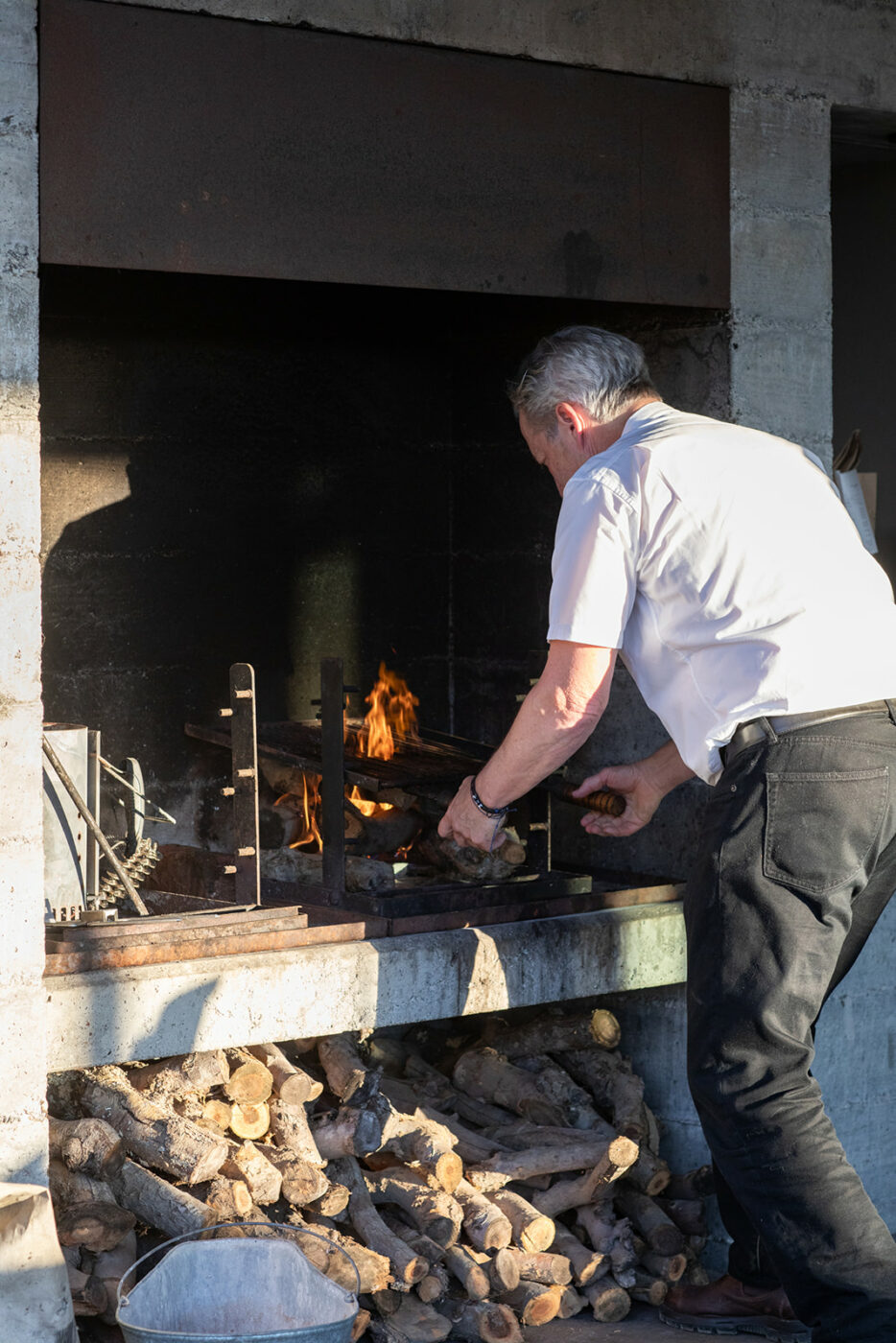
In June, the vineyards and olive groves come alive with the lush energy of the season, a sense of fertility and vitality, Singer says. “It’s a truism of painting that green can take over a painting. So in early summer, when you have all this green like you do here, you can’t keep it out. It feels like a welcoming presence, a waking up of your connection to the outdoors.”
From the porch, he can take in developing clusters on the vines and boysenberries and Santa Rosa plums in the garden. He also often sits on the porch at night to listen to the singing of the frogs in the creek and gaze at the sky. “When it’s moonlit, you can see the vineyards, and when it’s not, you can see the stars,” he says.
Though he has been in the wine business for 44 years and has farmed grapes on this site for two decades, Singer is still realizing new chapters in his relationship to wine. He recently relaunched under a new name, Singer Wine, and is focusing on smaller, high-quality releases. Learning to farm this land has been an introduction to a whole new canon of knowledge, he says, as he absorbed the character of the site and began to fully realize its promise.
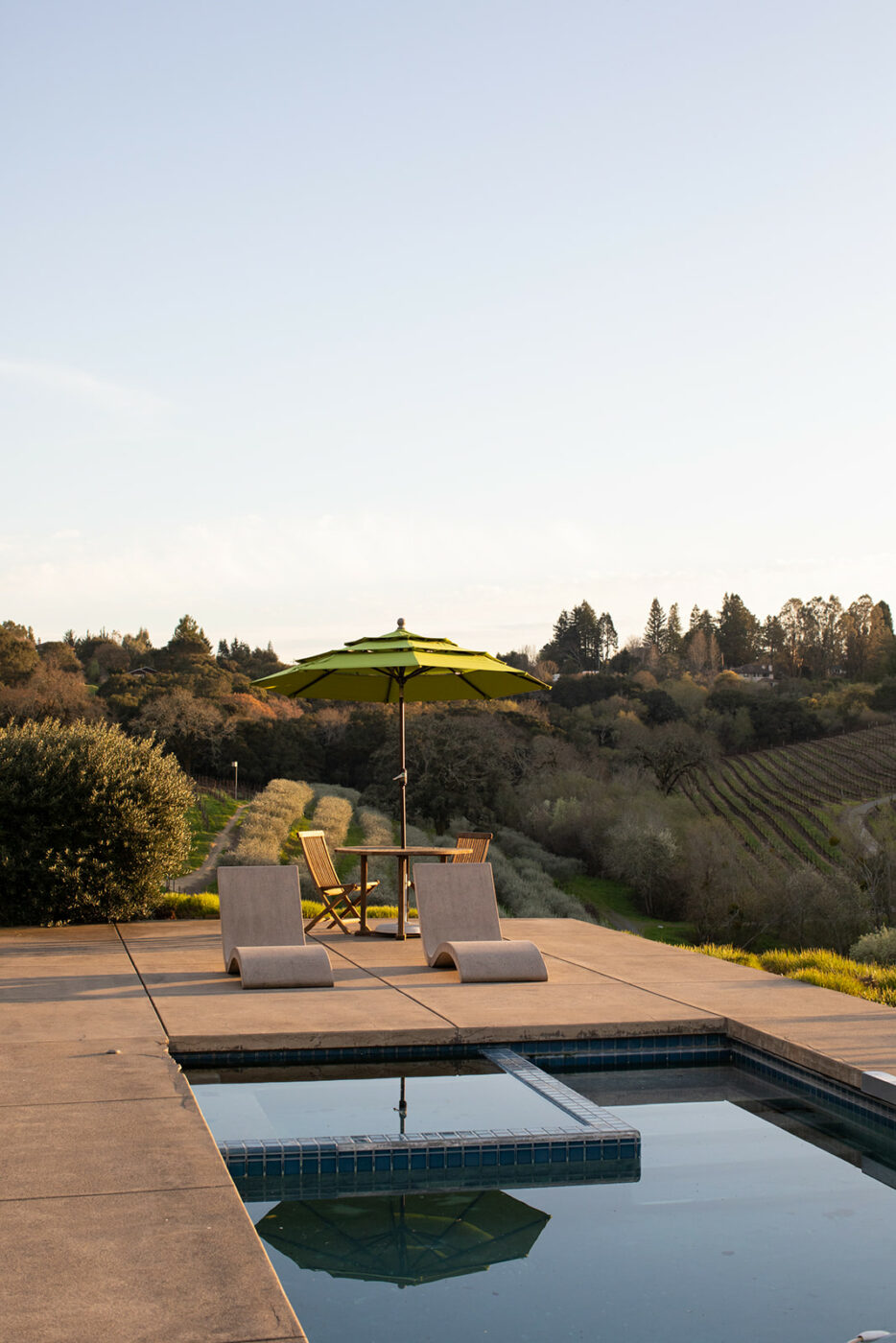
“One of the things that farming — especially organized, sustainable farming, where you’re not bluntly trying to impose your will — is you have to learn the systems. Not just how to accommodate them, but how to work within them. It’s another way of saying that it’s about trying to find a certain highly functional state of equilibrium. And that means also recognizing a system of balance and a relationship to all the other animals.”
“Having the opportunity to recognize all these different creatures — ducks, river otters, turkey, deer. It’s really fun to feel that we get to share this neighborhood.”
The post Stephen Singer Discovers a System of Balance at His Sebastopol Farm appeared first on Sonoma Magazine.
]]>
From Iggy Pop to Tom Waits, this man produced a number of albums in his Cotati recording studio. Now at age 72, he's returning to his original dream — to record his own music.
The post After Years of Producing Big-Name Acts, Mark ‘Mooka’ Rennick Is Working On His Own Dream appeared first on Sonoma Magazine.
]]>
















A farm boy from rural Illinois, Mark “Mooka” Rennick started recording local bands on a cheap analog tape machine while still a student at Sonoma State University in the ’70s. After buying a mixing board used by the Beach Boys, he moved to an old chicken farm in Cotati, where he built Prairie Sun Recording, a residential recording studio for top-notch artists who flocked from around the world to live, eat and breathe music together.
As word spread, many of his musical heroes showed up at his door: Tom Waits, Gregg Allman, Nancy Wilson, Primus, Faith No More, Wu Tang Clan, Van Morrison, The Doobie Brothers, Mickey Hart and Iggy Pop.
Two years ago, that journey came to an end as rent increases forced him to close the studio’s doors. But at age 72, in addition to working at satellite studios here and in Portland, Rennick is finally returning to his original dream — to record his own music.
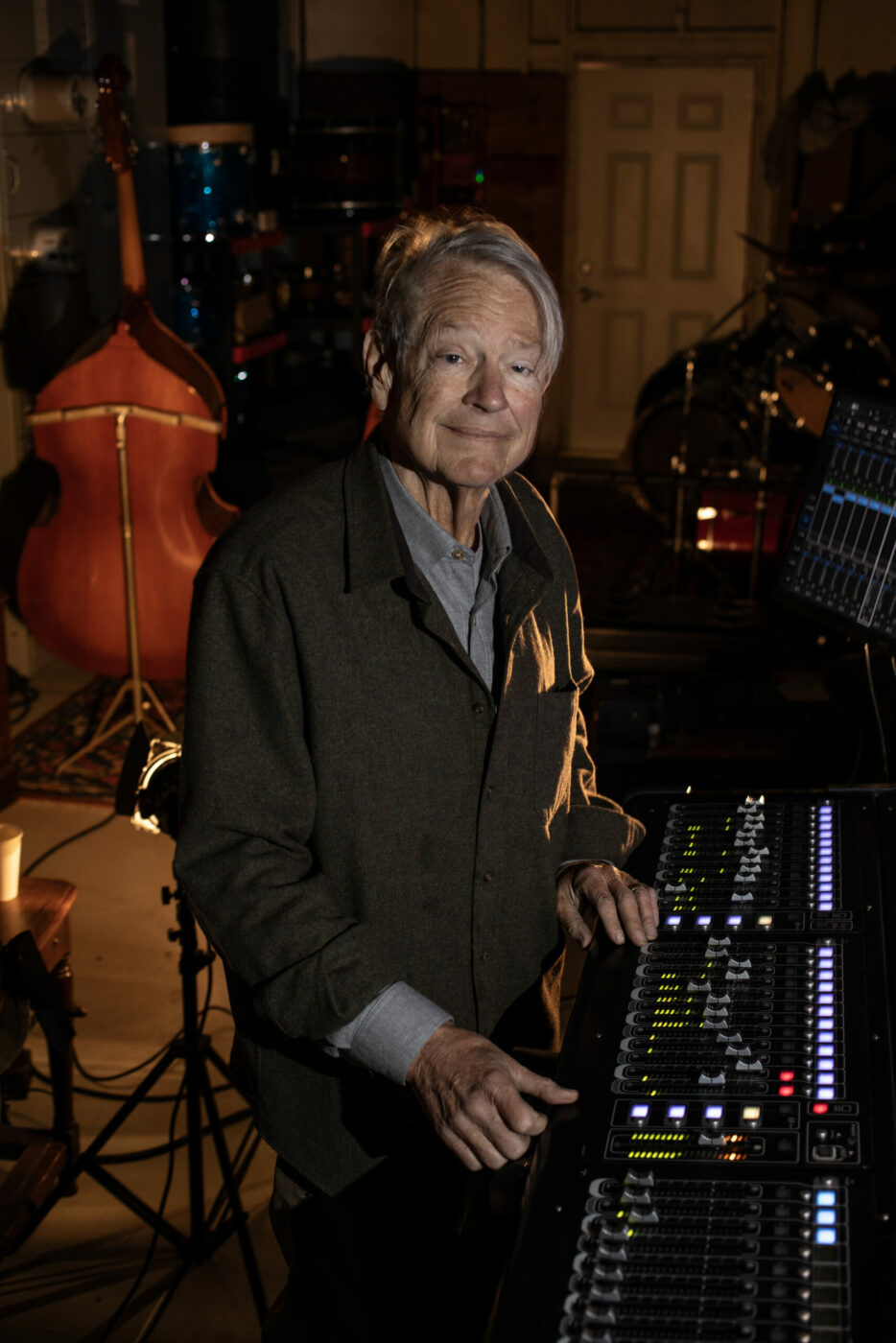
What’s in a name
There was a student newspaper at the University of Illinois called Prairie Sun. But, also, my good friend back home has a prairie restoration project that I’m still heavily involved in. I’ve been back to burn the prairie for the last five years in a row. Every spring, we go back. There are 10 acres under cultivation that we planted in 1972. It’s all about restorative agriculture and it all relates to the same world we have here in Sonoma County.
Musical memories
One of the great stories is Jack Kerouac, who was living at his mother’s house in Florida and sang one of his poems into his mom’s cassette recorder. Then Tom Waits came in and did a recording of that mix at Prairie Sun, and now it’s in the national archives.
Lessons learned
You learn humility and open-mindedness. We were 24/7, 365 days a year. Artists came from all over the world to live with us. You learn to give back, because you can get really insulated in your own little world. And these people became like family. We would have Thanksgiving with them and their children and their families. I’m still in touch with many of them.
New material
I finished an album called “Sons of Lincoln,” by this spoken-word collective I’m in called The Abolitionists. I still want to be a talent, and I’m working on finishing my own solo record, which I have over 225 tracks for. It’s not something I just started.
Over the years, as artists came through Prairie Sun — Dick Dale, Jack Antonoff, Prairie Prince — we recorded tracks together… Now, I finally have the freedom to work on my own record.
The post After Years of Producing Big-Name Acts, Mark ‘Mooka’ Rennick Is Working On His Own Dream appeared first on Sonoma Magazine.
]]>
Just back from a Middle East deployment with the U.S. Navy Reserves, Petaluma’s Aaron Webb sees his art career take off. But the decompression period isn’t easy.
The post A Petaluma Artist and Navy Officer Finds Beauty in the Shadows appeared first on Sonoma Magazine.
]]>
















From afar, Aaron Webb’s abstract paintings lure viewers in like a blurry windowpane, or a bird’s-eye view of a hazy coastline where wave break meets open sea.
But cast a brighter light, and the paintings reveal themselves in all their blemished glory. The landscape of the canvas becomes a marred universe littered with cracks, fissures, cuts, scars, scrapes and three-dimensional ridgelines that harden like scabs. From a different vantage point, hand-scrawled words like “not alone” or “the cure” sometimes emerge from the canvas.
“I love putting Easter eggs in some of these,” says Webb, his blue eyes lighting up a smile, almost daring you to find a hidden message as he props a new work up against a basketball goal in the driveway of his east Petaluma home. “Most people have no idea, even when it’s hanging on the wall. All of a sudden, they’ll turn and see it.”

On this day, he’s still readjusting to daily life after a seven-month Navy deployment in the Middle East. After preparatory training and post-operation debriefs, he was gone for a total of 15 months — so long he no longer remembers the building code to his downtown Petaluma studio. The key to his studio door isn’t working, so he opens the lock using a pocketknife he always carries.
The decompression period is always a weird liminal space, he says, not unlike his paintings.
With a foot in both worlds, he’s just started a new job in human resources at a Bay Area tech company, even as he is still processing events from this latest deployment, including the deaths of two fellow sailors. On other deployments, like during the surge of 2007-2008 in Iraq, casualties were higher. Ask him what he does in the Navy, and he remains intentionally vague, alluding to “taking care of logistics” for various units.
“I’ve seen some stuff,” he says.
Webb has spent 20 years with the Navy and continues to serve in the reserves, where he was recently promoted to master chief petty officer, one of the highest ranks for an enlisted man. He still apologizes for having “the mouth of a sailor,” and his body is tattooed with ships, tillers and cannons. One of them reads, “We Have This Hope As An Anchor For The Soul.”
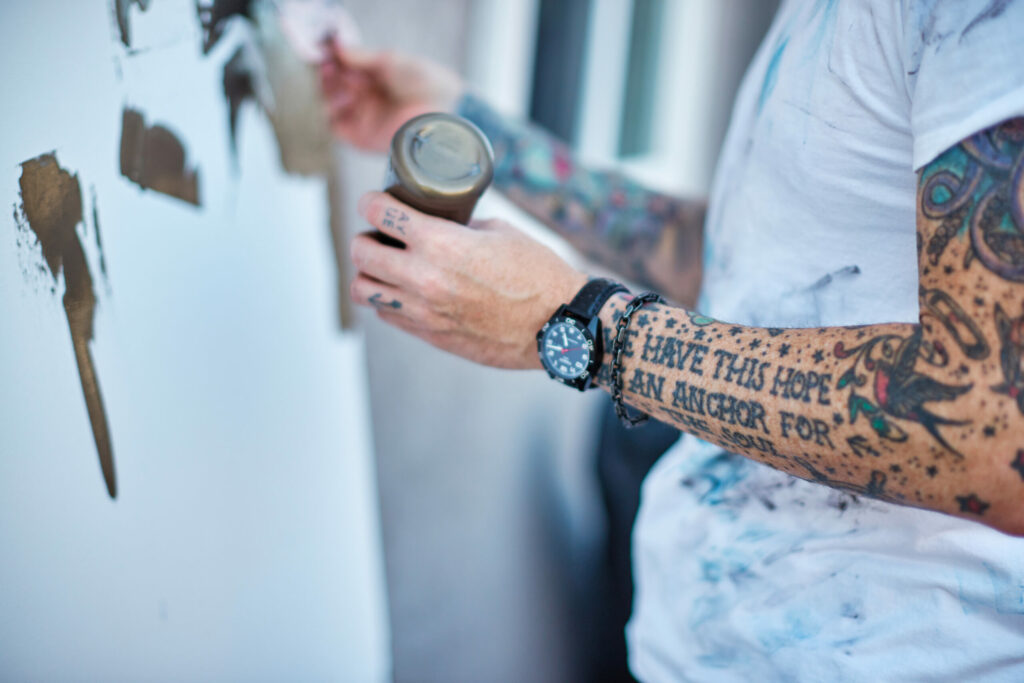
He’s had experiences he’ll never forget, no matter how hard he tries. One painting came to him in a wave of tears, triggered months after a friend and fellow sailor died by suicide on Christmas Day. The loss hit Webb one day while painting in his garage, as a musical algorithm landed on a Snow Patrol song his late friend had played over and over when they were in Iraq together.
He titled the work “To Feel Finality.” As the painting runs from top to bottom, it could be the journey of a life, wading through the chaos of daily battles, scratched tally marks and what looks almost like a game of hangman, until it reaches the final third — a horizontal red line giving way to a thicker black line, the metaphor complete.
Later, in his living room, Webb nods to a work in progress hanging above a couch. The moody colors could be the gloaming at the end of the day, or maybe a silent battlefield the day after a war ends, drenched in dew and dark shadows before sunrise. It’s the first thing he’s painted after returning home.
“I put it up on the wall when I get to the point where I just need it to talk to me,” he says. “Then I sit with it and see what I need to do with it.”
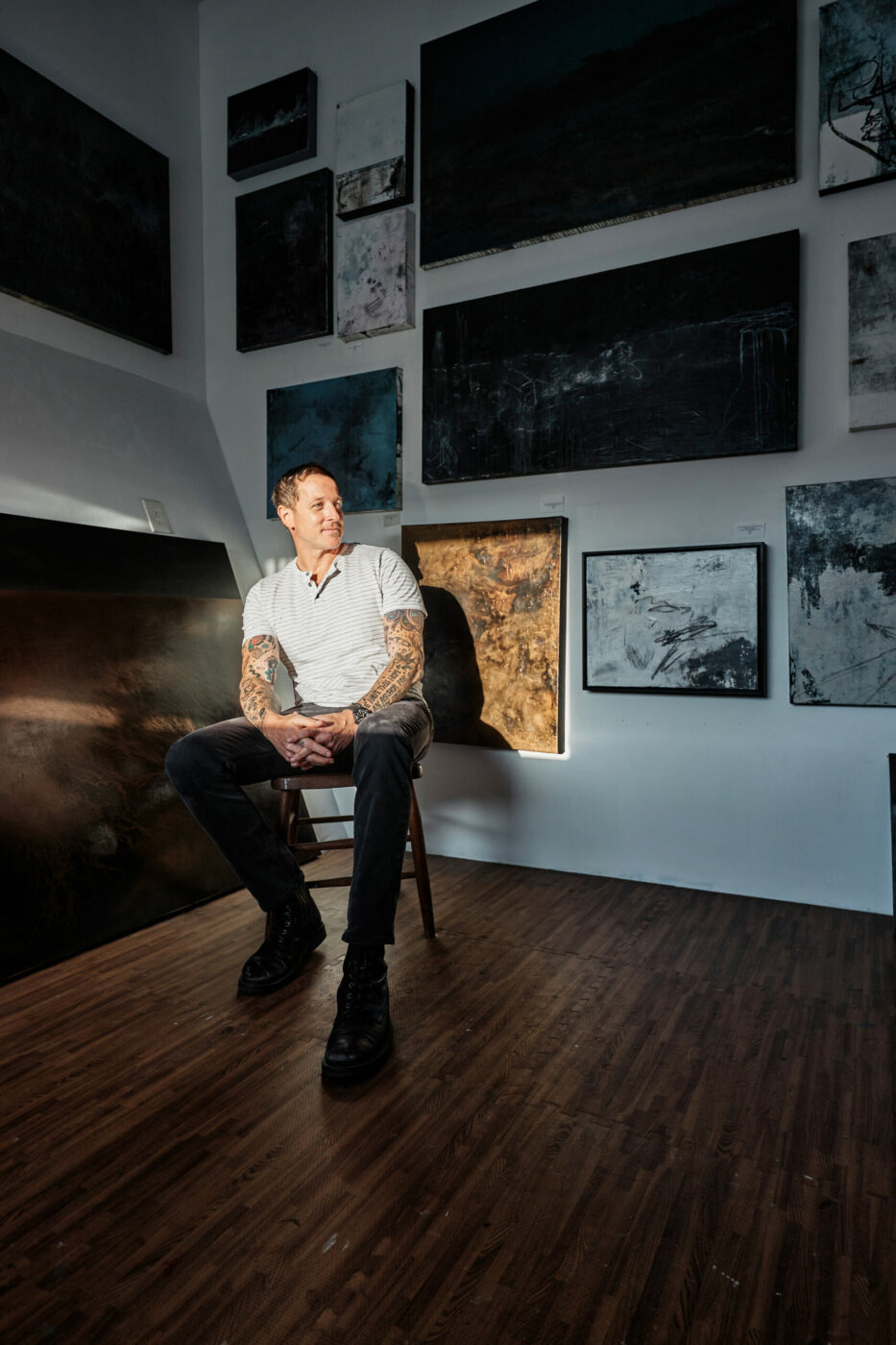
Moving to the garage, where Webb builds his 6-by-8-foot wooden frames, he returns to a common theme in his paintings — the lingering sense of “decay.” As he’s talking, a tiny spider emerges from beneath the canvas of a half-finished painting and crawls along the edge. He quickly swats it with his hand, leaving a rust-colored stain.
“It’s all very organic,” he says, smiling.
Rum, sea salt, dye, ink, watercolor, latex, acrylic and detritus — they all find a home in Webb’s abstract worlds.
The titles of his paintings — like “Pull Me Out From Inside” or “The Quiet Story of Their Stars” — give hints, suggesting words for the wordless, like poetic names for experimental, instrumental jazz songs. “Sick for the Sight of You” is cloaked in painted-over, awl-engraved words. Awash in waves of turmoil, “The Dead and Dreaming” borrows from a Counting Crows lyric. And “Am I All For Nothing” bleeds in black down a 6×8-foot canvas, something that came to him while watching from home as U.S. armed forces retreated from Afghanistan, culminating with the frenzied exit at the international airport in Kabul.
He’s always dabbled in art, whether playing guitar or studying fashion design, but it wasn’t until Webb stumbled on watercolors and art supplies at a base exchange a decade ago that he seriously took up abstract painting as a way to take his mind off the chaos around him. Now, everywhere he travels with the Navy, he brings a miniature studio. Some of his fellow soldiers are intrigued and ask questions, while others could care less, he says.
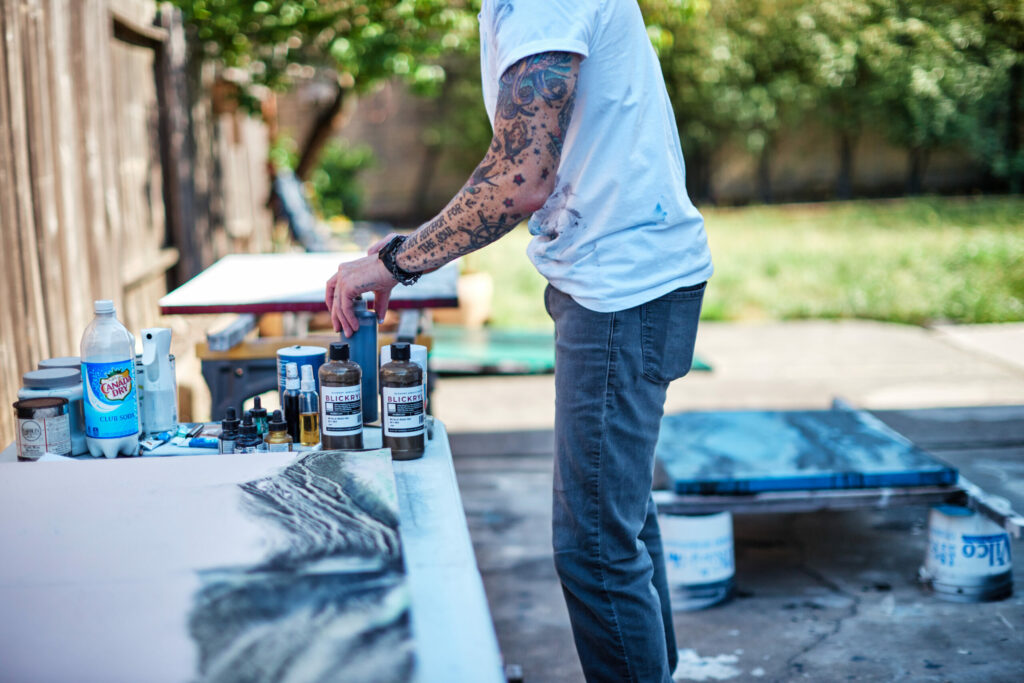
Otherwise, he usually paints at home, whenever inspiration strikes, often outside along the side of his house where the sun bakes the layers of paint, and the morning dew dries and seals it in a ghostly glow. Propping the canvas on small buckets, maybe a foot off the ground, he paints flat, occasionally tilting the work at angles for inks and dyes to run through cracks between paint layers. He learned through trial and error that rum gives liquidity to dyes and inks, and sea salt crystalizes regions with thicker texture. Instead of brushes, he uses scraping tools you might find next to cans of Bondo putty at Home Depot.
Webb was raised with two older sisters in a conservative, religious household in Beaumont, Texas, an oil town 45 minutes inland from the Gulf of Mexico. Their father was a professional photographer, and Webb would spend hours in the darkroom with him, mesmerized by images coming to life in the ethereal developer solution. In high school, he was an all-state basketball player.
His painting “Drowning in the Depths of Grace,” part of his Lost at Sea series, grapples with how “church and religion played a huge part of my life growing up, but not as much now,” and how “the concept of grace is hard for people to wrap their head around.”
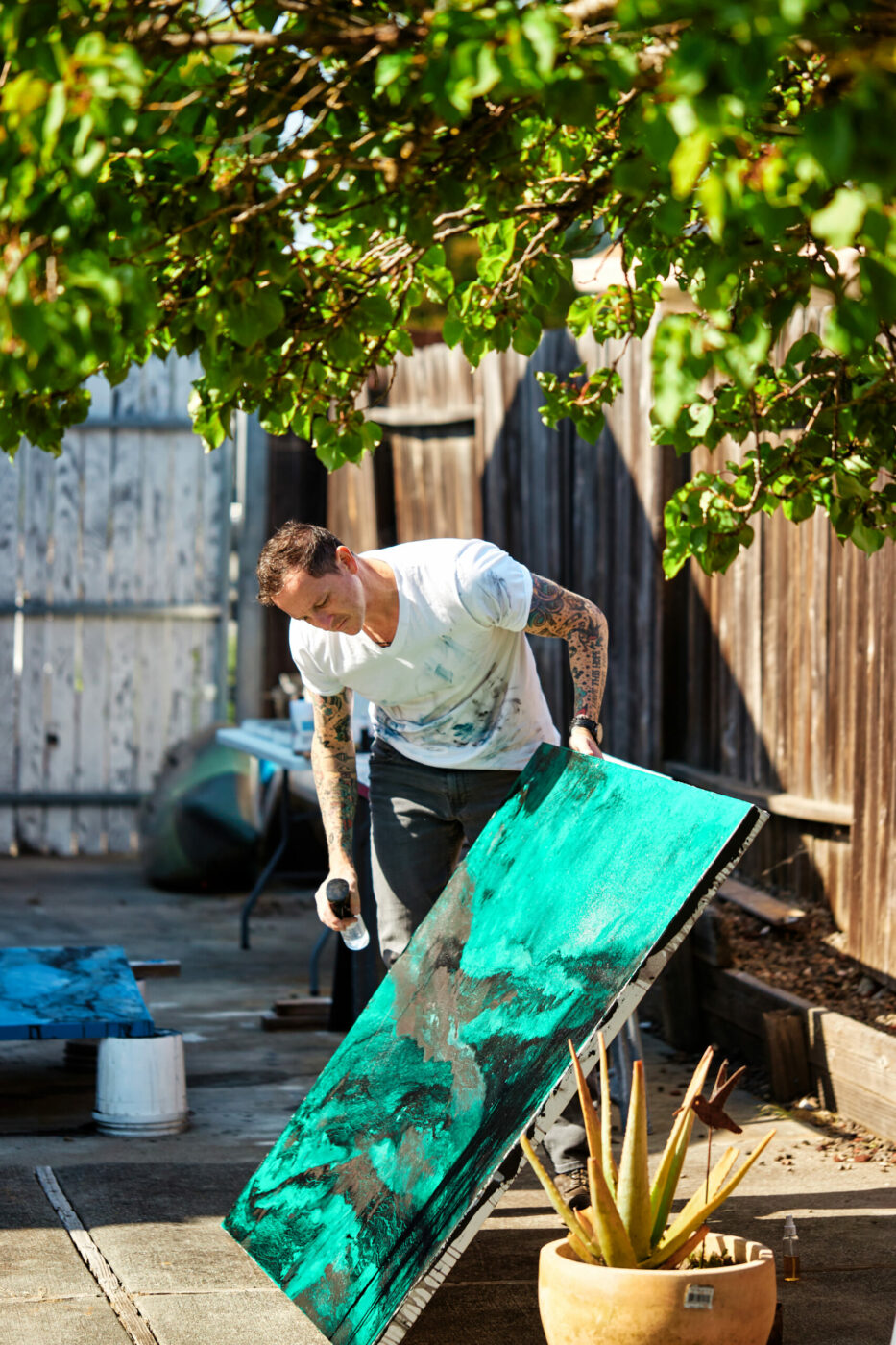
In August, Webb will mount a solo show at Rena Charles Gallery in Healdsburg, where owner Rena Charles was introduced to his work through a photographer she also represents. In less than a year, Charles has sold several of his paintings. One of Webb’s paintings now hangs on the wall of a prominent New York commercial real estate office; another is headed to a bed-and-breakfast in Calistoga.
“People often ask if the marks are intentional,” Charles says. “And I share that they are, and they represent the journey that you’re on, whatever that is. And I explain how Aaron shares that it’s in that in-between space – that’s the growth and those things that you learn along the way.”
Over time, Webb has come to realize maybe he doesn’t need to inflict so much pain on the paintings, gouging them with his emotions. Standing beside an older piece, he says, “I scratched it, and it works. But if I wouldn’t have done it — it’s beautiful enough and big enough that it doesn’t need it. It still communicates what it needs to, without it.”
In 2021, he was part of a group show at the National Veterans Art Museum in Chicago. But he’s wary of being pigeonholed as “a veteran artist” who might be collected and curated only into veteran art exhibits. In his eyes, he is an artist who also happens to serve his country — not exclusively a “veteran artist.” But he can’t escape who he is and where he’s been.
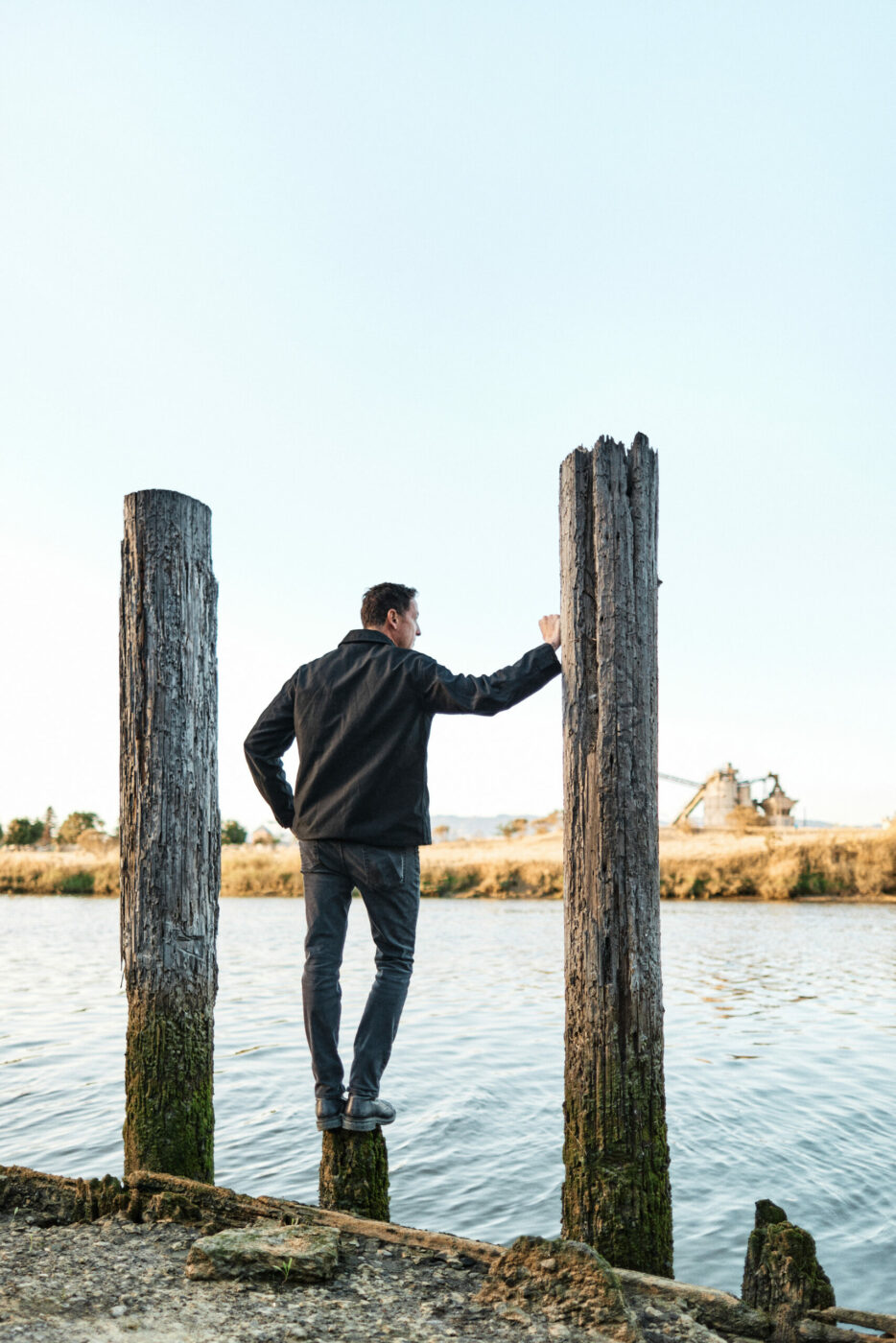
He also can’t escape the mixed emotions of war. “There’s not a direct tie to a bad day or something happening in the field,” he says. “It’s more like flashes and snapshots of memories and emotions that you felt — sometimes things you didn’t even know you felt, until they come back 15 years later.”
Making art is how he makes peace with himself. “This is kind of my own therapy,” he says. “I never went through art therapy. This was my own way of working through it. I just find if I create, I’m better. I have better mental health, and I’m happier.”
Once the work is done and hanging in someone else’s living room or bedroom, it no longer matters [to him] how he made peace with it.
“It took time, but now I realize it has nothing to do with me,” he says. “It’s about them and the art and what they see and what they feel.”
In that, he finds solace — knowing he’s not the only one who seeks refuge in the space between beauty and decay.
Aaron Webb’s upcoming solo show runs Aug. 15 – Sept. 30 at Rena Charles Gallery, 439 Healdsburg Ave., Healdsburg. Open 11 a.m. to 5 p.m. Sunday through Friday and 10 a.m. to 6 p.m. Saturday. aaronwebbstudio.com
The post A Petaluma Artist and Navy Officer Finds Beauty in the Shadows appeared first on Sonoma Magazine.
]]>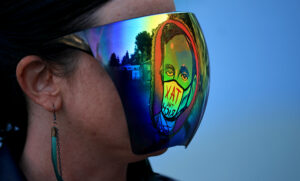
Sonoma County’s anonymous Velvet Bandit, a former school lunch lady, opens up about her shift to punny, political street art.
The post Underground Sonoma County Artist Shares Inspiration Behind Popular Street Art appeared first on Sonoma Magazine.
]]>
















Every superhero has an origin story. For Sonoma County’s anonymous Velvet Bandit, it started off innocently enough.
Imagine a 46-year-old school lunch lady going about her daily routine — one day pizza, the next, sloppy joes. Then all of a sudden, a pandemic hits. Laid off, and at home with two kids, she was inspired to try street art for the first time. It felt urgent, like shouting into the void to see if anyone was listening.
So, late one night in March 2020, she pasted up a small painting of a toilet-paper roll with the words “Let’s Roll” under a bridge along the Santa Rosa Creek Trail. “I stood back and thought, ‘Oh my god, that looks so cool,’” she remembers. “Then I went back into my studio and started painting a bunch more. I was instantly hooked.”
Since then, she’s pasted hundreds of vibrant street paintings on alley walls, utility boxes, and street signs from Willits to Los Angeles. They’re often punny (“Not mushroom for hate here” written on a fungus). Sometimes they’re political (“Tax the Rich” on Abraham Lincoln’s face). And other times oddly inspirational, like an award ribbon that reads, “Didn’t quit my job today.”

As word spread and fans shared photos on Instagram (where she has more than 10,000 followers), a Petaluma restaurant hired her to paint a window, and a cider company asked her to decorate cans and bottles.
If the artist has to make a public appearance — at an art show or on a vlog, she often wears masks or a pink wig and dark sunglasses. Never revealing her real name (because, well, street art isn’t exactly legal, just ask Banksy), she is still known only as the Velvet Bandit.
What’s in a Name? “One of the very first things I bought for myself after my ex-husband moved out was a green velvet couch. I slowly started acquiring more velvet things, like a velvet throw pillow and a velvet bedspread. One of my friends suggested ‘Velvet Bandit,’ and I loved it because it was feminine, but also with the word ‘bandit’ in it.”
Strange Encounters “I was in a situation where a man came out and said, ‘Hey, what are you doing? Stop that!’ That wasn’t fun. He called me a nut job. Later, I went back, and he had taken the paste-up down that I had put up. So I went back and painted a squirrel that said ‘Nut job.’”
Unexpected Outcomes “People have wanted to Venmo me money, and they didn’t want anything in return. They just wanted to help replenish my supplies because they loved it so much. And that was just mind-blowing to me that people wanted me to do art with nothing in return because they were getting such a kick out of it.”
Family Backing “At first, my kids (ages 13 and 16) thought, ‘What’s Mom doing? This is a little crazy.’ But once they saw that I was getting a little publicity, and people were rallying behind me, then they came on board. Now, they think it’s pretty cool.”
The post Underground Sonoma County Artist Shares Inspiration Behind Popular Street Art appeared first on Sonoma Magazine.
]]>
Bryan Tedrick's career is on fire.
The post Fabricating Fantasy: Local Artist Wields Powerful Burning Man Sculptures appeared first on Sonoma Magazine.
]]>
















As the sun drops toward the dusty horizon on a sweltering August evening in Nevada’s Black Rock Desert, it catches the eye of the coyote.
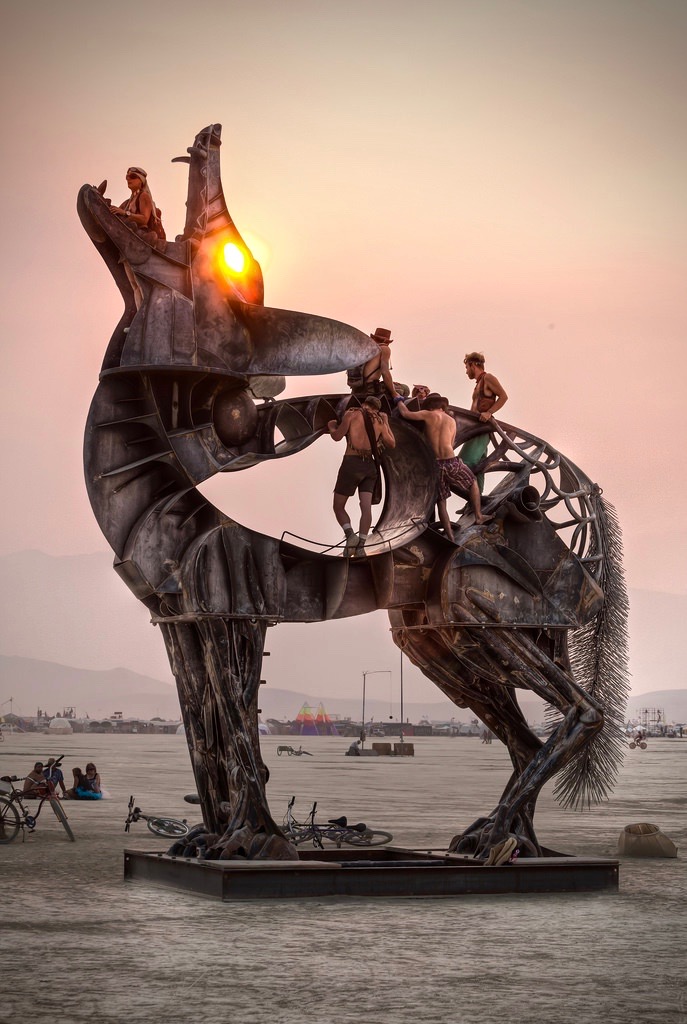
The modern bacchanal of Burning Man is in full swing, and many of its revelers have congregated around a 26-foot-high steel coyote crafted by Glen Ellen artist Bryan Tedrick. The moment when the sun shines directly through the space that defines the coyote’s eye has the feeling of an eclipse: it lasts for just a few moments and seems to cast an otherworldly spell over those who observe it.
The Burners — some climbing on the coyote, one in its upraised jaws — howl. A photographer looking west takes a photo — featured prominently in the pictorial book “Burning Man: Art on Fire” — that becomes one of the defining images of the 2013 festival.
The coyote, forged from seven tons of steel, is just one of Tedrick’s works to grace Burning Man’s desert plateau in northwest Nevada. The weeklong festival, a celebration of alternative art and culture, is the ideal exhibition space for Tedrick’s art, which is far too large to fit in most galleries.
-
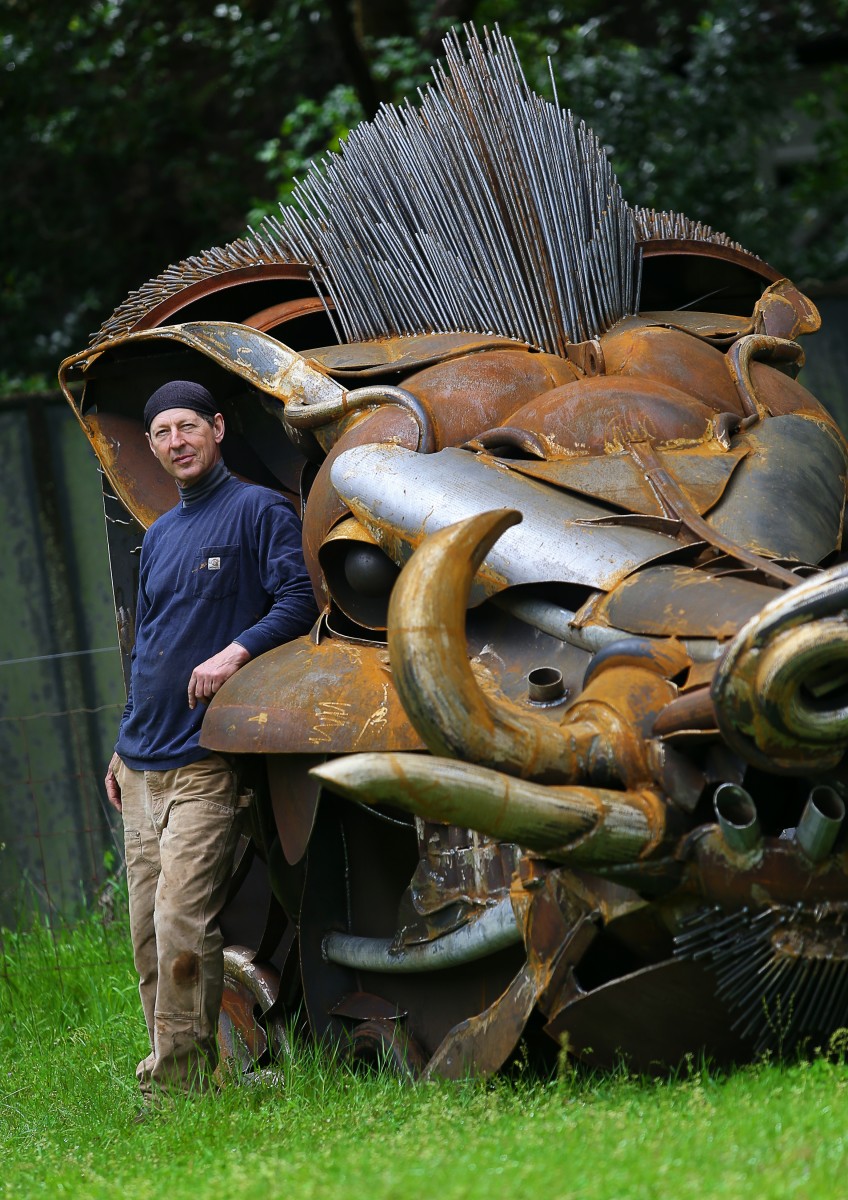
Bryan Tedrick with the head of a sculpture for this year’s Burning Man: a gargantuan, diabolical-looking wild boar he calls “Lord Snort.” Tedrick, 60, first attended Burning Man in 2005. His initial reaction: “Whoa, there really is a lot going on,” but he wasn’t impressed with much of the art.
“It’s essentially an unjuried show, so anybody can bring anything out there,” he said. “But there were a few pieces that were monumental in scale and really well-done, so I thought, ‘Oh, there are some people out here who are doing good work, and they’re the ones getting grants.’” Submitting a drawing of a pair of wings with a 6-foot-diameter ring in the center,
Tedrick applied for a 2008 Burning Man grant. He was the last artist funded that year, he said, receiving $10,000. The sculpture, previously installed next to The Kenwood Restaurant, is now located at the Wine Country Garden Design Center, just south of the Sonoma plaza on Highway 12.
According to Tedrick, grants vary, but $25,000 and under is typical, with the expectation that artists will do additional funding on their own. The 2016 budget for funding art is approximately $1.2 million. If a work is sold, Burning Man collects 10 percent of the sale price, not to exceed the original grant amount.
-

Bryan Tedrick’s “Spread Eagle” sculpture. Tedrick said when he delivered “Spread Eagle” to the playa, festival administrators “looked at me sideways and said, ‘You need to apply every year because we love your work.’” He enjoys fabricating immense works that Burning Man attendees can climb, constructing them in ways that encourage people to become part of the art. With “Spread Eagle,” the ring was just the right size for an adult to stand in, arms outstretched like Leonardo da Vinci’s “Vitruvian Man.”
For this year’s desert gathering, Aug. 28 to Sept. 5, Tedrick fashioned a gargantuan, diabolical-looking wild boar he calls “Lord Snort.” It’s approximately 20 feet tall and 30 feet wide.
A professor once encouraged him to make larger-than- life art, which inspires a sense of physical danger. “If a piece is shorter than me, it doesn’t have enough power to command my attention,” said the 6-foot-4 Tedrick. “But if it’s bigger than me, then I have to pay attention to it.”
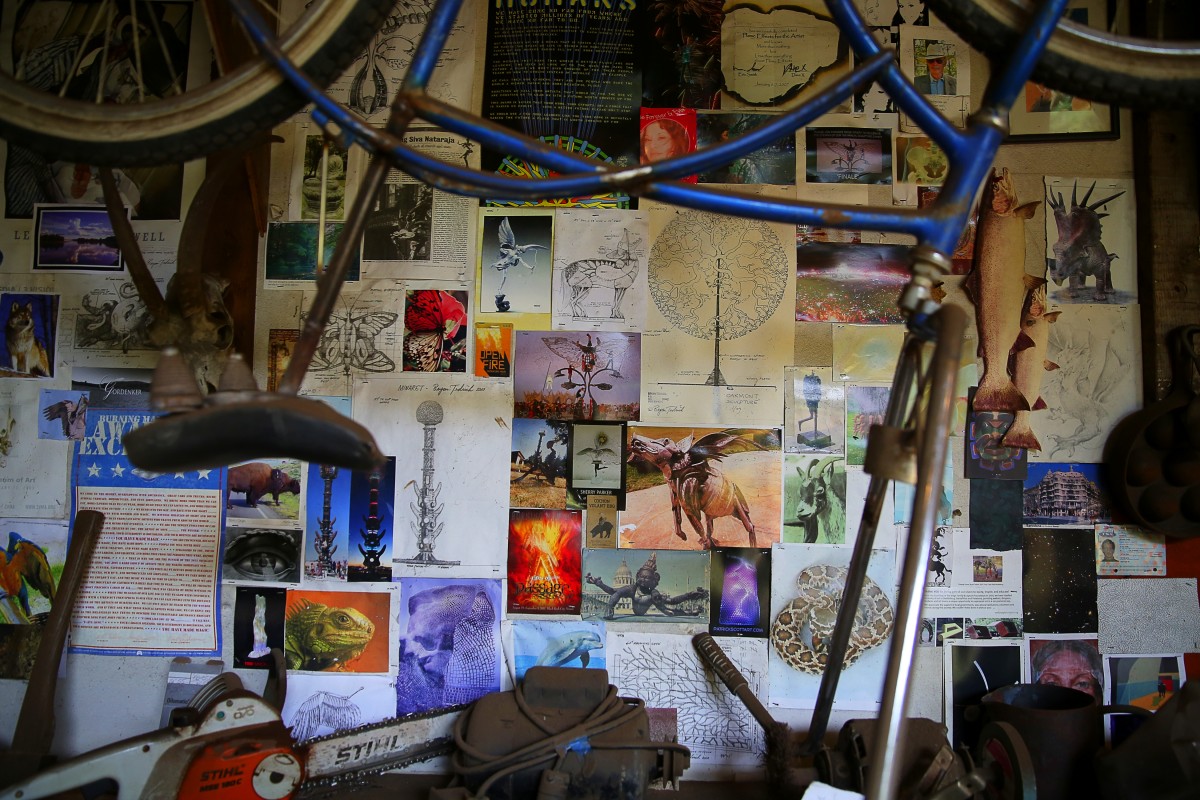
Photos of completed sculptures, their plans, and inspirations are stuck on a wall of Bryan Tedrick’s workshop, near Glen Ellen. Steel is his main medium. “It’s easy to work with, there’s lots of it around, it’s relatively cheap, very durable, and it lends itself to a spontaneous method of fabrication,” Tedrick explained. He uses a plasma cutter and then welds the pieces together.
He hopes the boar ends up with the coyote’s owner, Ken Wilson of Wilson Artisan Wineries. Wilson bought the coyote after the 2013 Burning Man and installed it at Wilson Winery, on Dry Creek Road in Healdsburg.
“He wants the boar to look super-aggressive and ready to leap onto Highway 12 and wreak havoc,” Tedrick said of “Lord Snout.” If Wilson follows through with the purchase, the boar will be installed at his St. Anne’s Crossing Winery in Kenwood.
In his late teens, Tedrick worked as a rigger at Kaiser Shipyards in Richmond, but said he always wanted to make art. He attended the San Francisco Art Institute in the early 1980s, where he learned to weld and immersed himself in sculpture. With money saved while working at the shipyard, he purchased land on the coast.
“I had a little cabin in Gualala, so I really didn’t have any responsibilities,” Tedrick recalled. “I had a place to live, so I could afford to live the life of an artist.”
His wife, Terry Roberts, wanted to raise their kids in a less remote area, so they got a place in Glen Ellen, where they remain today. His rented studio is not far from his home, where he imagines and assembles his whimsical creations.
“It does help to have a place where I can be undistracted, so I can focus,” he said. “And it really helps to have a routine.” Tedrick’s credo: Whether you feel inspired or not, show up.
-
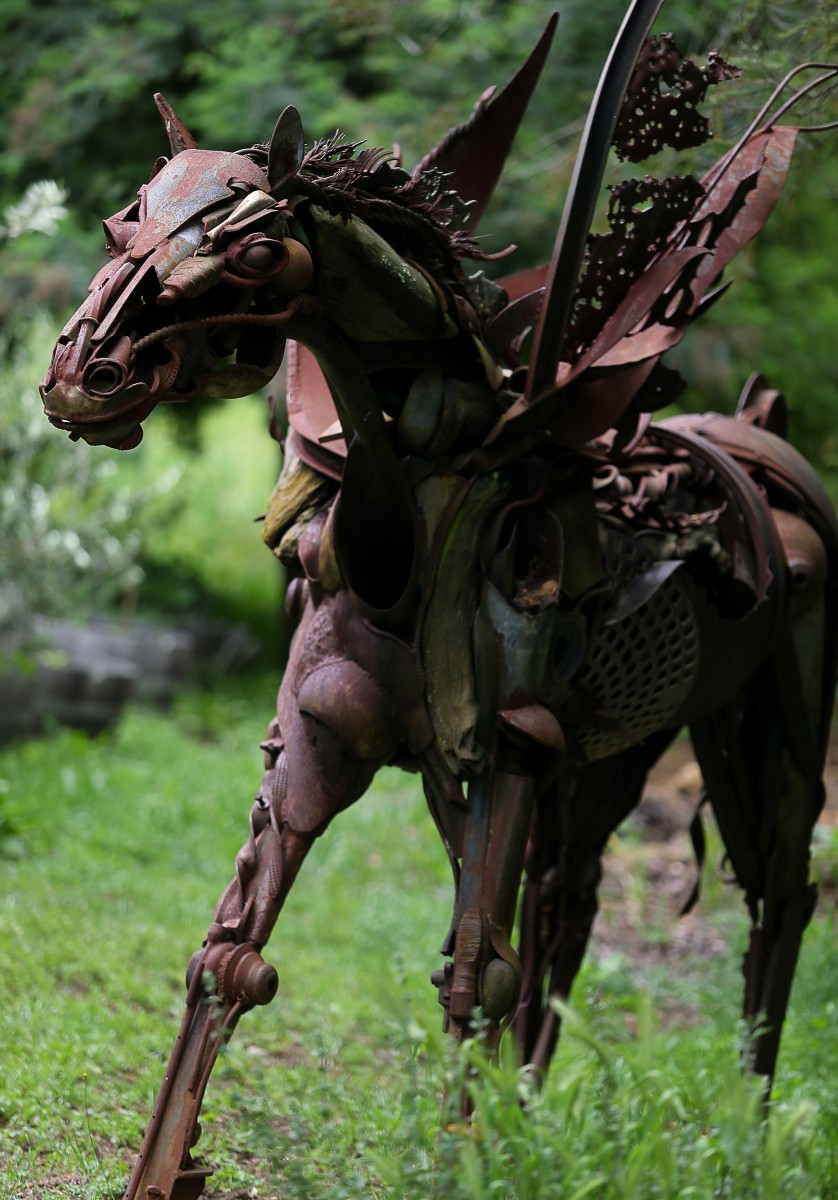
Horse sculpture near Bryan Tedrick’s front gate made of steel, bronze, rocks and wood. Near the front gate is a horse he made years ago of steel, bronze, rocks and wood. An old facing from a vacuum cleaner is the horse’s rear end, and dark stones form the eyes. The lifelike animal appears to be lunging forward with every muscle.
“The main thing is to avoid straight lines,” Tedrick said. “Straight lines are static and kill the piece. They look really stiff. So everything should have just a slight curve to it. It’s just a matter of being sensitive enough … to adjust those lines until it feels real. Every line has an emotion. There are sad lines and uplifting lines. If you slow way down, you can feel those lines.”
Although he hires a crew to help install his mammoth works at Burning Man, the easygoing Tedrick usually works alone.
“I like the privacy, being able to focus and concentrate,” he said. “I’m definitely into the low-stress life. In Glen Ellen, I feel like I’m in heaven.
-
-
The post Fabricating Fantasy: Local Artist Wields Powerful Burning Man Sculptures appeared first on Sonoma Magazine.
]]>